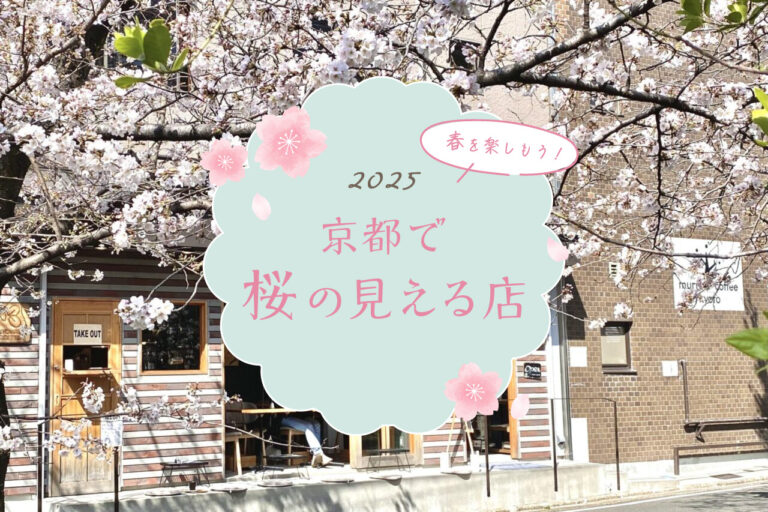
[Let's enjoy the spring! Kyoto's cherry blossom viewing...
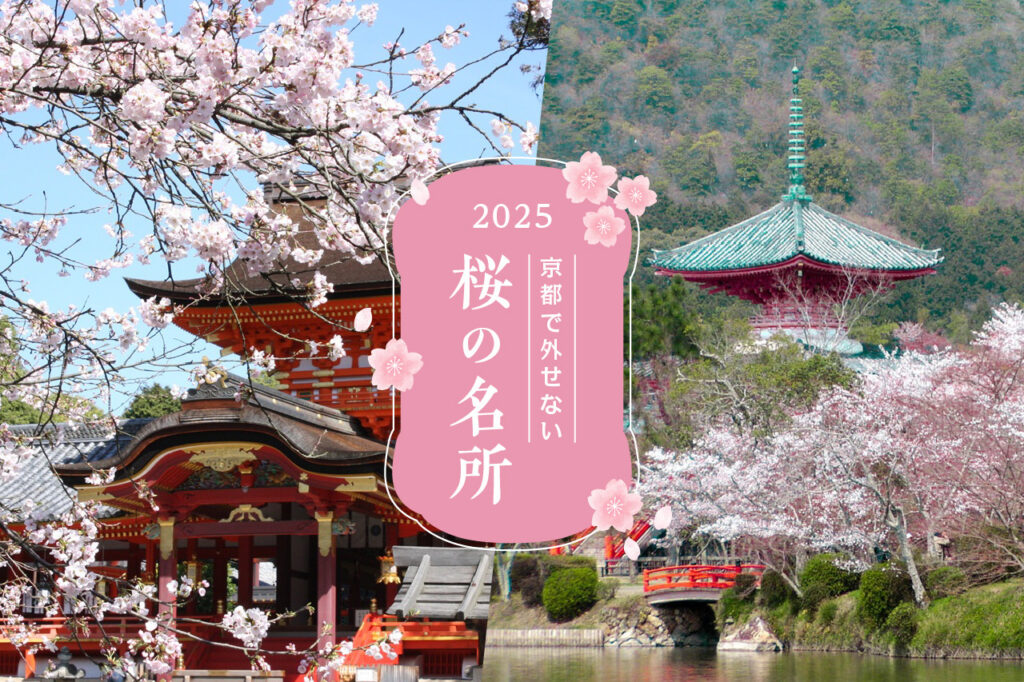

The cold weather has eased up and we can feel the arrival of spring. Many people may be looking forward to the blooming of cherry blossoms. In this issue, we will introduce a selection of cherry blossom viewing spots in and around Kyoto, including famous cherry blossom viewing spots representing Kyoto in spring, as well as spots where you can enjoy cherry blossoms at night when they are lit up. When you visit Kyoto, enjoy cherry blossom viewing along with sightseeing.
In Kyoto in spring, cherry blossoms are in full bloom everywhere you walk in the city, and the whole town is decorated with colorful blossoms. Check out the MAP and have a relaxing time in Kyoto in spring!
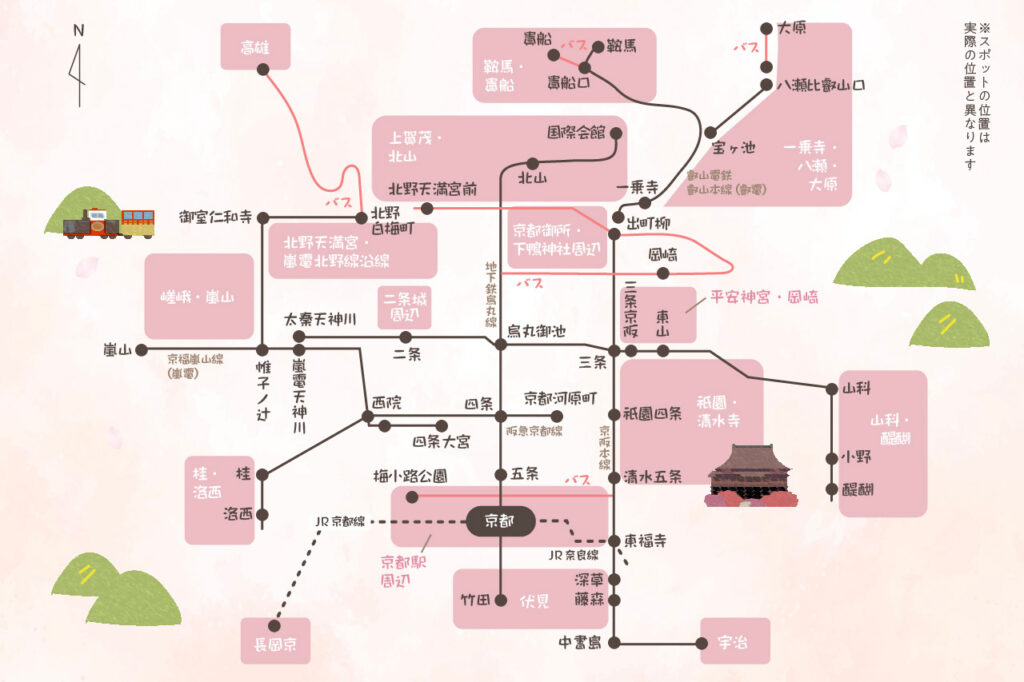

Toji Temple was founded in 796 (Enryaku 15) as a temple for the protection of the nation. The five-story pagoda, a national treasure, is one of the symbolic landscapes of Kyoto. About 200 cherry trees, including Someiyoshino cherry trees, are planted in the precincts of the temple. The "Fuji-zakura," a beautiful red weeping cherry tree said to be 130 years old, comes from Morioka City, Iwate Prefecture. Enjoy the beautiful contrast between the five-story pagoda, the tallest in Japan, and the Fuji-zakura.


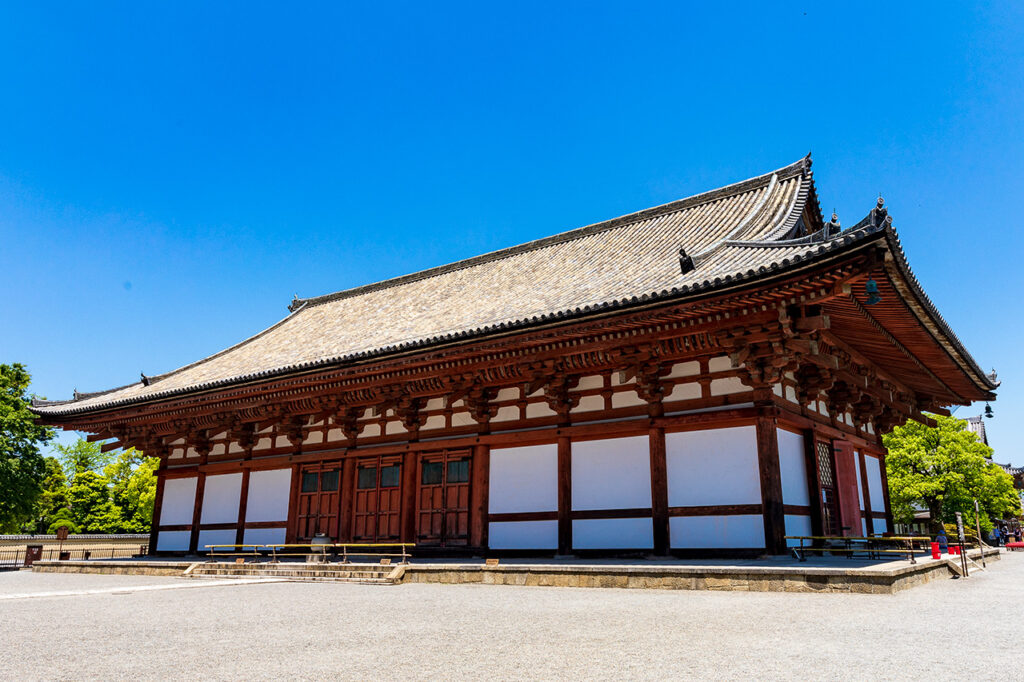
Kondo, a lecture hall, and a dining hall are lined up near the gourd pond. After enjoying the cherry blossoms in the garden, you can admire the majestic Buddhist statues.

Best time to visit: Late March - early April
Visiting hours/Kondo, Auditorium 8:00-17:00 (Reception ends/16:30)
Treasure House (only during the exhibition period) Kanchiin 9:00-17:00 (reception closes at 16:30)
*Gates open from 5:00 to 17:00
The Treasure House, Spring Special Viewing: Toji Masterpieces - National Treasure Twelve Heavenly Screens and Kannon (Perfection)
Period / March 20, 2025 (Thursday, national holiday) - May 25, 2025 (Sunday)
Hours: 9:00 - 17:00 (Registration closes at 16:30)
Admission: Adults 600 yen, Junior high school students and under 300 yen
Cherry blossoms illuminated at night (Kondo and Kodo special nighttime viewing)
Period / March 15, 2025 (Sat) - April 13, 2025 (Sun)
Time/18:00 - 21:30 (Registration closes at 21:00)
Entrance fee: 1,000 yen for adults, 500 yen for junior high school students and younger
Light up the new greenery (special nighttime viewing of Kondo and Kodo Hall)
Period / April 26, 2025 (Saturday) - May 6, 2025 (Tuesday, national holiday)
Time/18:00 - 21:30 (Registration closes at 21:00)
Entrance fee: 1,000 yen for adults, 500 yen for junior high school students and younger
Kiyomizu Temple is one of the representative temples of Kyoto.
In December 2020, the roof was re-thatched for the first time in half a century, and the main hall, known as the stage of Kiyomizu, was redecorated. The grounds of the temple are filled with approximately 1,000 wild cherry trees and someiyoshino cherry trees, and the view from the main hall is exceptionally beautiful. The view from the main hall is exceptionally beautiful. During the special nighttime viewing in spring, visitors can enjoy the ethereal scenery of the main hall surrounded by illuminated cherry blossoms at night.
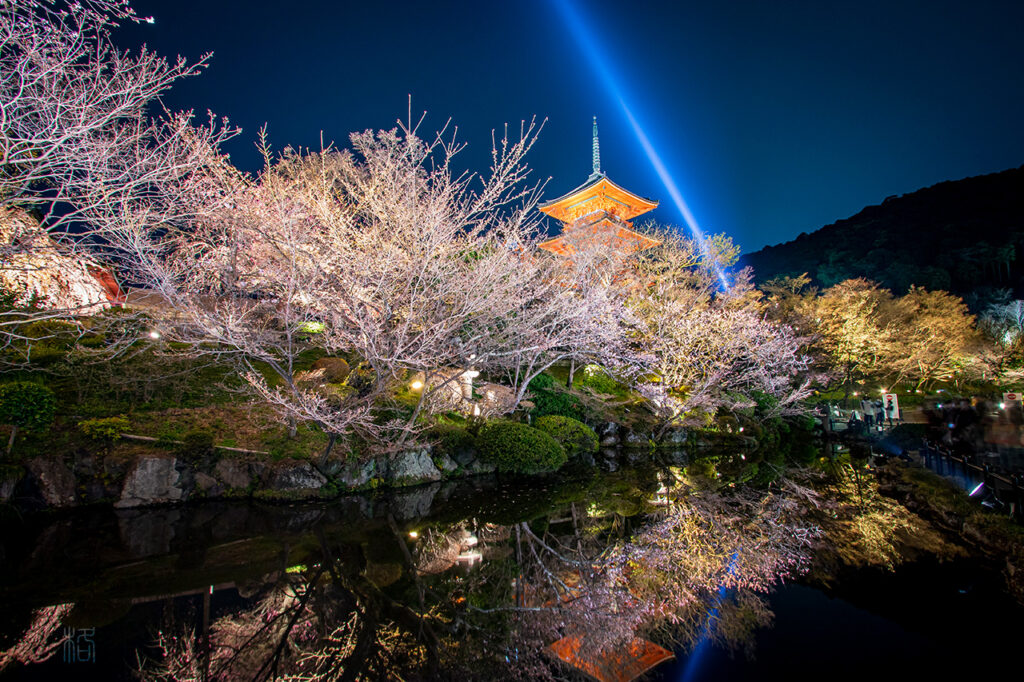
Photo courtesy of Kiyomizu Temple



Best time to visit: Late March - early April
Opening hours/6:00-18:00 (varies according to the season)
Admission: 500 yen for adults, 200 yen for elementary and junior high school students
Kodaiji Temple was built by Nene Kodai-in, the wife of Hideyoshi Toyotomi, a.k.a. Kita Masasho, to mourn the loss of Hideyoshi Toyotomi. The weeping cherry trees in the Hojo and Hashinniwa gardens, which are popular at this temple, add to the setting during the special spring viewing period. At 5:00 p.m., the entire temple grounds are lit up, creating a fantastic scene that differs from that of the daytime.
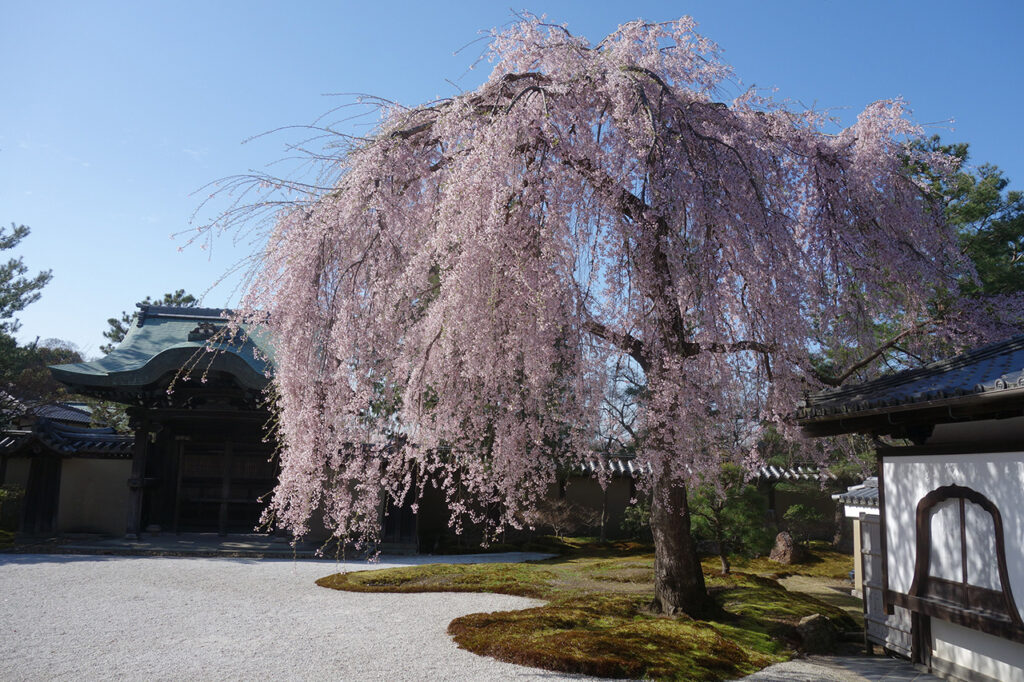

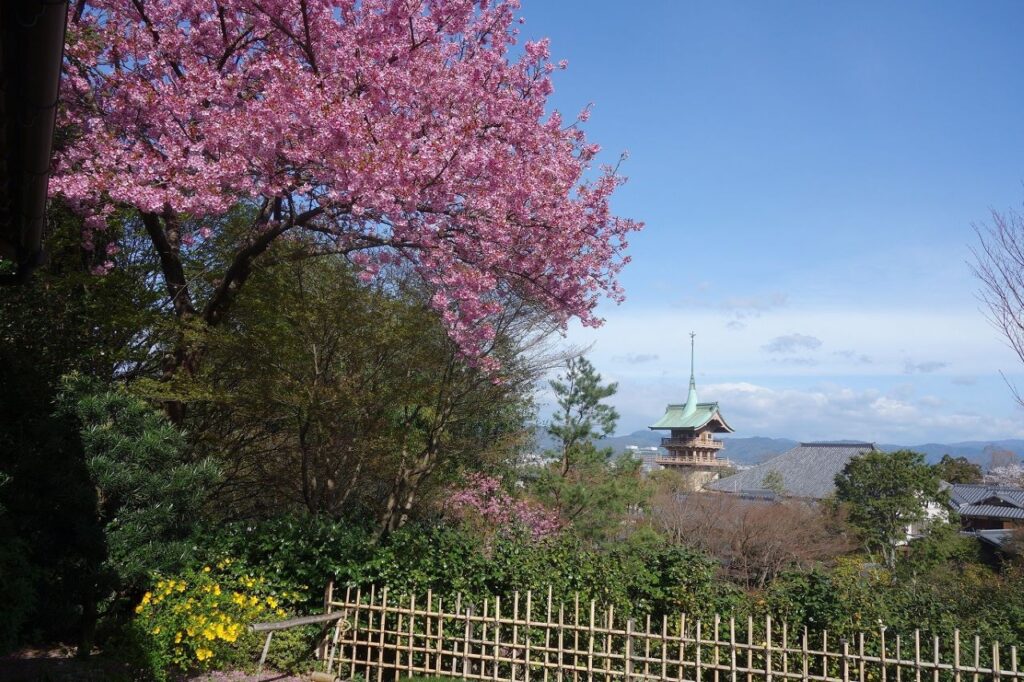

Best time to visit: Late March - early April
Hours: 9:00-17:30 (last admission at 17:00)
Spring Special Exhibition: "The Heart of the Moon: Wish Upon a Cherry Blossom" at Kodaiji Temple
Period of visitation / Wednesday, March 5, 2025 - Wednesday, April 30, 2025
Hours: 9:00-22:00 (last admission at 21:30)
Admission/ Adults 600 yen (with admission ticket to Palm Art Museum), Junior high and high school students 250 yen
Discounted tickets for two temples (Kodaiji Temple, Palm Art Museum and Entokuin Temple): 900 yen
Spring Night Special Viewing "Prayer - Spring
Period of visitation / Friday, March 14, 2025 - Tuesday, May 6, 2025 (national holiday)
Hours: 17:00-22:00 (last admission at 21:30)
Admission/ Adults 600 yen (with admission ticket to Palm Art Museum), Junior high and high school students 250 yen
Discounted tickets for two temples (Kodaiji Temple, Palm Art Museum and Entokuin Temple): 900 yen
Maruyama Park, the oldest park in Kyoto, opened in 1886. The grounds are a circular Japanese garden, dotted with restaurants and teahouses. The park is known as one of the best cherry blossom viewing spots in Kyoto, with approximately 680 cherry trees, including weeping cherry trees, someiyoshino cherry trees, and mountain cherry trees, and the entire park is decorated with cherry blossoms during the cherry blossom viewing season. In the center of the park is a 100-year-old second-generation weeping cherry tree, which is famous for its illuminated appearance as the "Gion no Yozakura" (Gion cherry blossoms at night). A special hanami teahouse will be set up so that visitors can enjoy viewing the cherry blossoms while drinking and eating at their leisure.


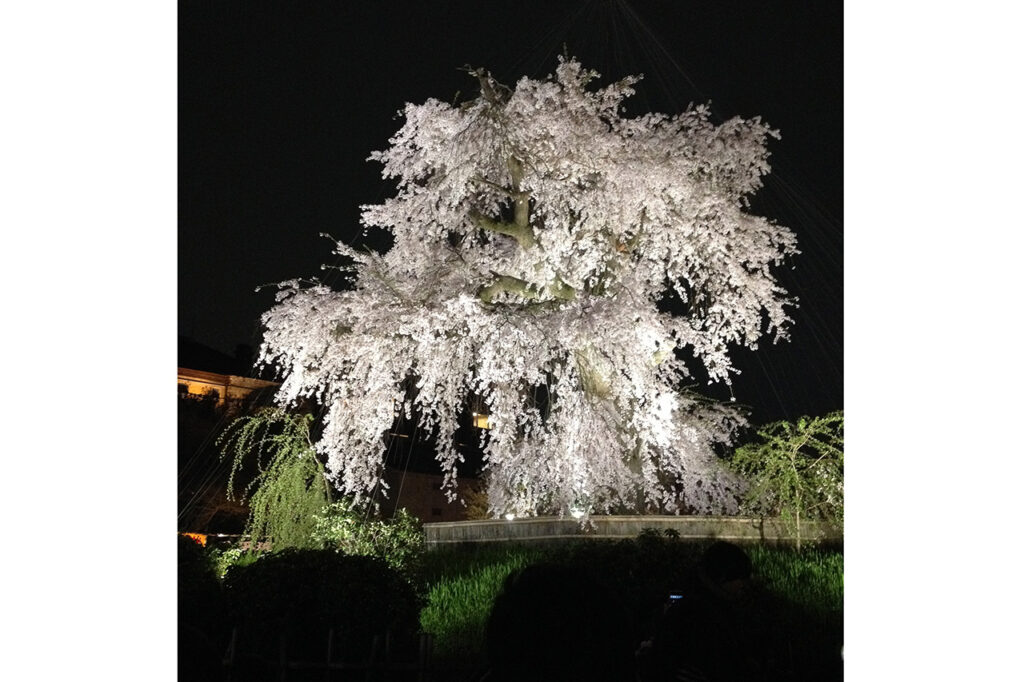

Best time to visit: Late March - early April
Entrance fee / Free
The weeping cherry tree in Maruyama Park is illuminated.
Period / Tuesday, March 25, 2025 - Wednesday, April 9, 2025
Hours/18:00-22:00
free in the park
*Placement (spreading out blue sheets, etc. to reserve a place in advance) is prohibited.
The head temple of the Jodo sect [Chion-in]. Cherry blossom trees line a wide area from Higashiyama Hwacho-zan to Higashioji-dori. The scene of one of the largest wooden double gates in Japan, the National Treasure Sanmon Gate, surrounded by cherry blossoms is also a must-see. At night, the Yuzen-en Garden, with its magnificent weeping cherry blossoms, the National Treasure Mikageido, and other areas of the temple grounds are lit up.
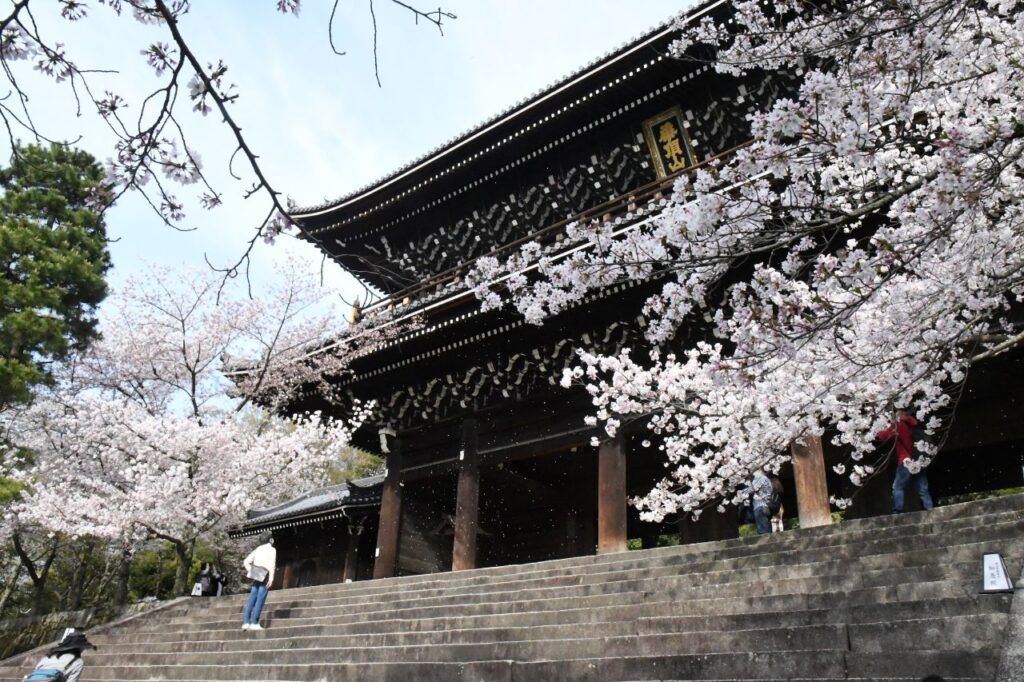

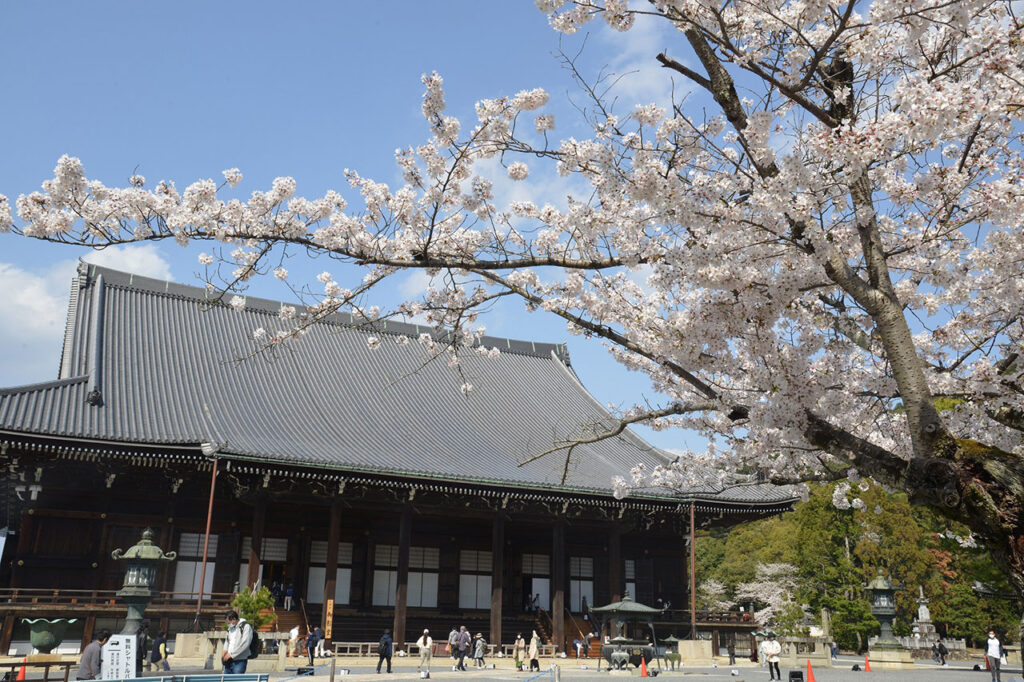

Best time to visit: Late March - early April
Hours: Yuzen-en 9:00-16:00, Hojo Garden 9:00-15:50
Common ticket sales end at 15:20.
*Gate closes at 16:30
admission fee
Yuzen-en / Adults 300 yen, elementary and junior high school students 150 yen
Hojo Garden/adults 400 yen, elementary and junior high school students 200 yen
Common garden ticket / adults 500 yen, elementary and junior high school students 250 yen
Chion-in Spring Light-up 2025
Period / Wednesday, March 26, 2025 - Sunday, April 6, 2025
Hours: 17:45-21:30 (reception closes at 21:00)
Admission fee: 800 yen for adults, 400 yen for elementary and junior high school students
The area along the Shirakawa River that runs from Higashiyama to the Gion area is called "Gion Shirakawa. The area around Tatsumi Bridge and Tatsumi Daimeishin Shrine in Gion, where stone-paved streets are lined with town houses with red latticework, is called "Gion Shinbashi Bridge" and is designated as an Important Preservation District for Groups of Traditional Buildings. It is one of the most popular spots in Kyoto and is often used for filming. In spring, someiyoshino cherry trees and weeping cherry trees are in full bloom, adding color to the scenery that evokes the atmosphere of Kyoto. At night, the cherry blossoms are illuminated, creating a different, more glamorous atmosphere than in the daytime.
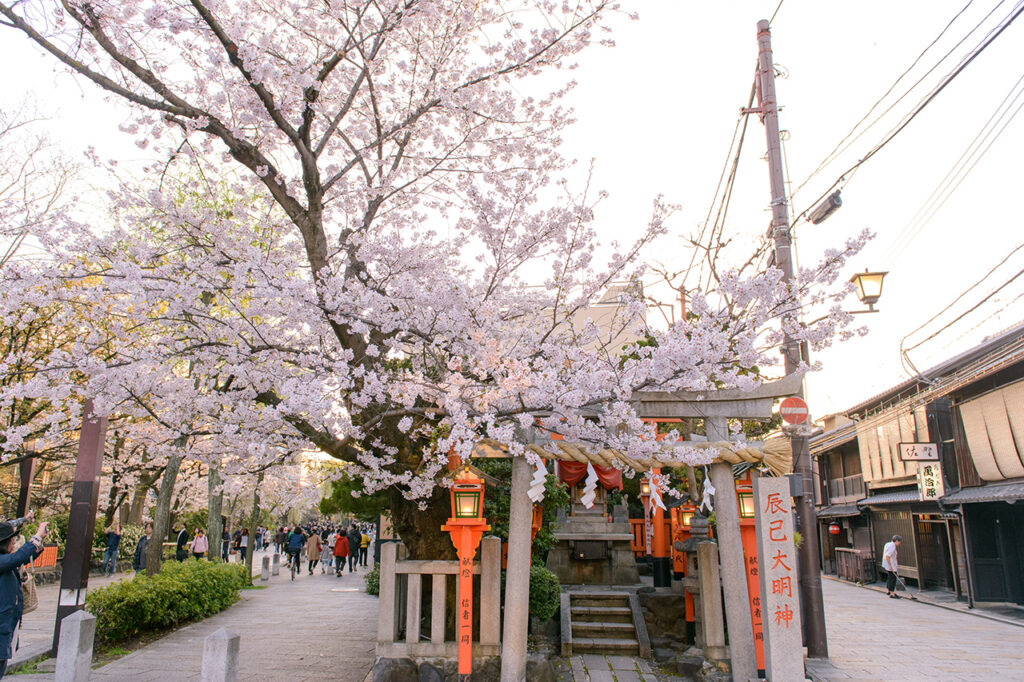



Best time to visit: Late March - early April
The 32nd Gion Shirakawa Yoizakura Light-up
Period / Friday, March 28, 2025 - Sunday, April 6, 2025
Hours/18:00-22:00
Fee/No charge
Kiyamachi-dori, one of Kyoto's most famous shopping streets, is an emotional townscape along the historically famous Takase River. Along the Takase River between Kiyamachi 2-jo and Kiyamachi 5-jo, approximately 360 Someiyoshino and other cherry trees are planted, delighting visitors. The cherry blossoms are sometimes illuminated when they are in bloom, so you can also enjoy the cherry blossoms at night.




Best time to visit: Late March - early April
free to stroll (i.e. to take a stroll)
The Keage Incline was built from the Meiji period to the Showa period (1868-1912) to allow ships traveling on the Biwako Sosui (Lake Biwa Sosui) to move without discharging their cargo. It connected the Keage Sosui and Nanzenji Sosui, which had a large difference in elevation, and was known as the world's longest incline railroad at the time of its construction. With the decline of the shipping industry, the line was abandoned and is now a cultural asset of Kyoto City. Visitors can freely walk on the tracks, which are decorated with someiyoshino cherry trees and yamazakura cherry trees in spring.
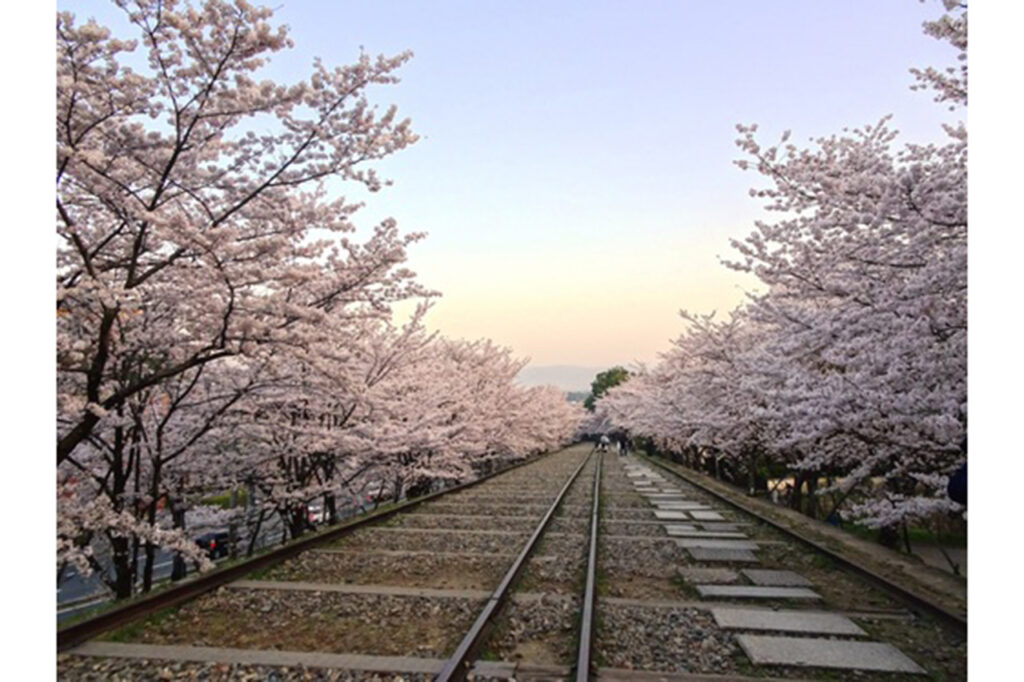
Photo courtesy of Kyoto City Water Supply and Sewerage Bureau

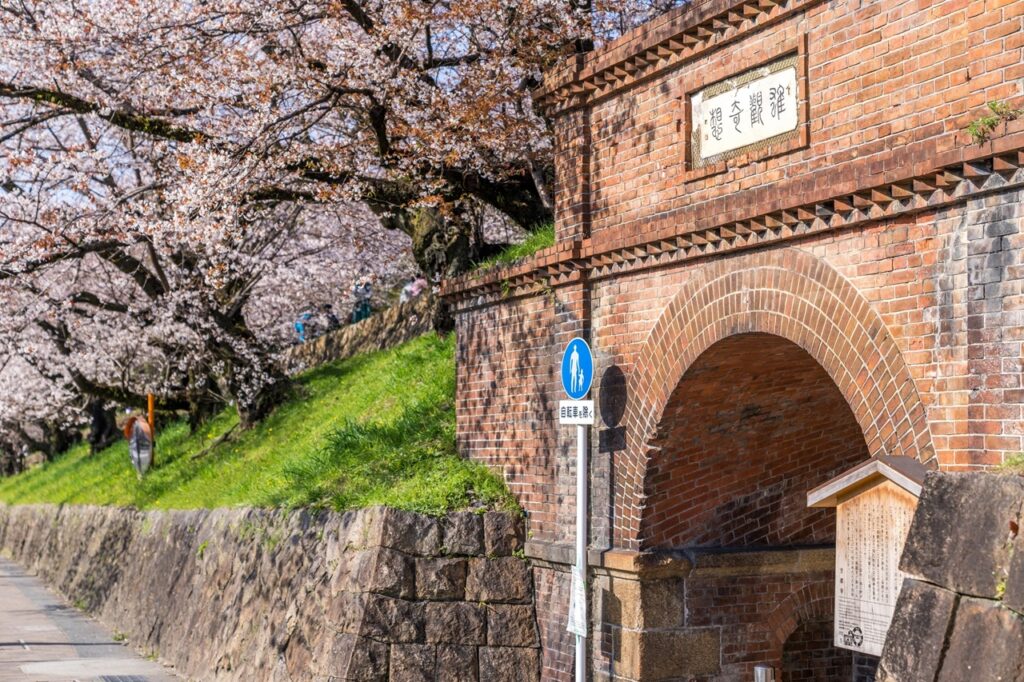
Photo courtesy of Kyoto City Water Supply and Sewerage Bureau

Best time to visit: Late March - early April
Kyoto's largest vermilion Otorii (Grand Gate) towers over Heian Jingu Shrine. About 300 cherry trees, including someiyoshino and red weeping cherry trees, are planted here, which contrast beautifully with the vermilion of the Otorii gate and the shrine pavilions. Every year, a cherry blossom viewing tea ceremony is held when the weeping cherry trees are at their best, and tea tables are set up. In the evening, the "Benishidare (red weeping weeping) Concert" is scheduled to be held. Gagaku (ancient Japanese court music), piano, and violin performances will be held, offering an extraordinary experience.
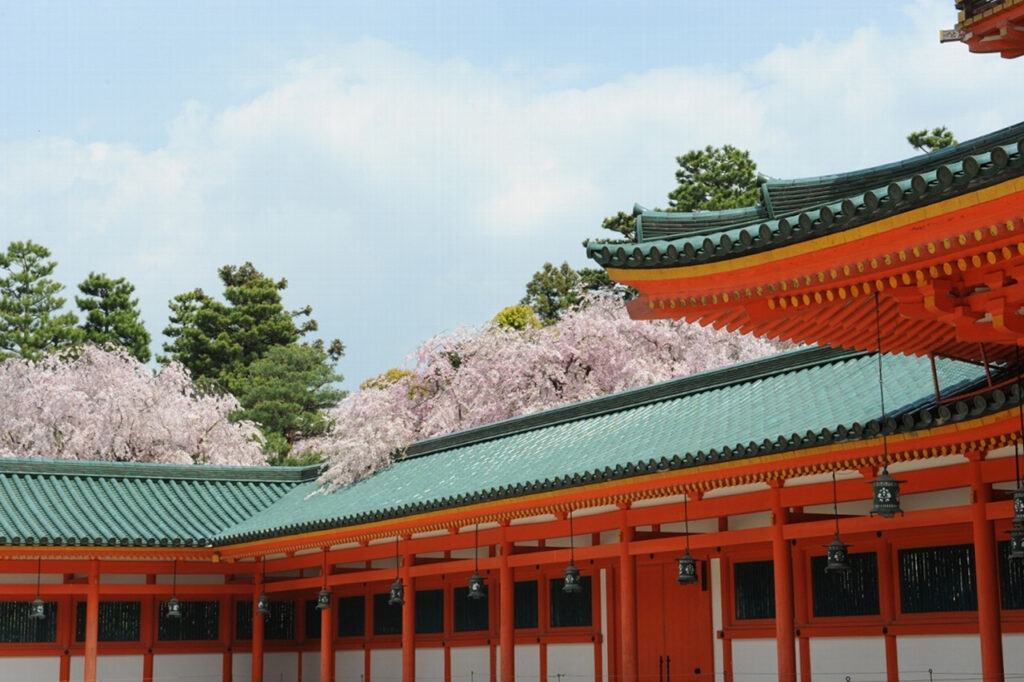

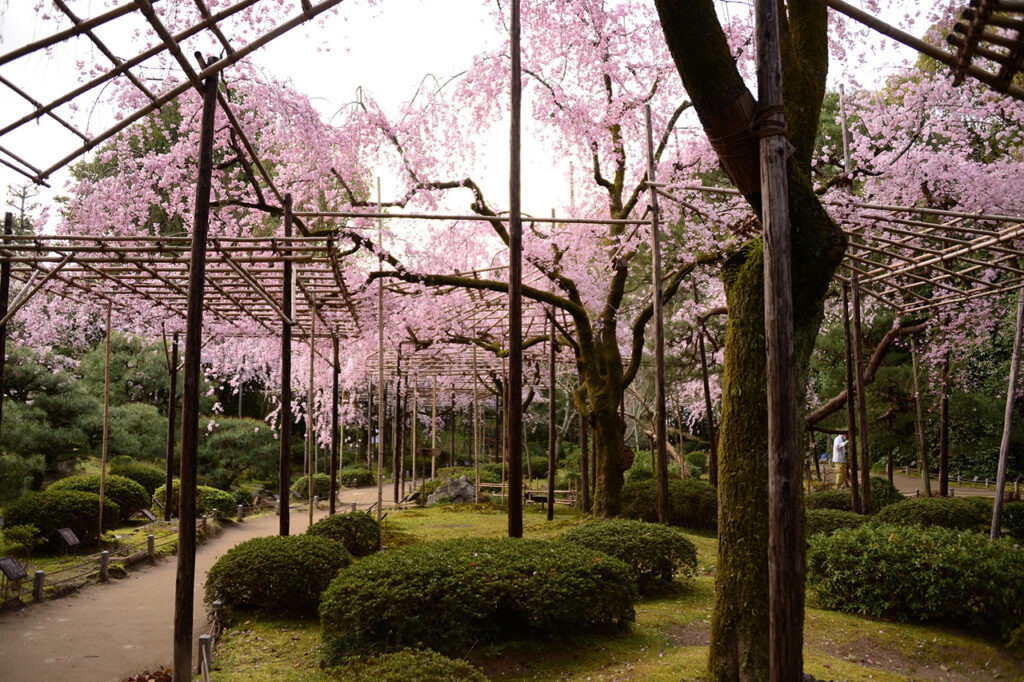

Best time to visit: Late March to mid-April
Visiting hours may change depending on the season. Detail isOfficial sitesee
"Cherry Blossom Viewing Tea Ceremony"
Period / Saturday, March 29, 2025 - Wednesday, April 9, 2025
Hours: Tea ceremony 9:00-16:00 (last admission at 15:30), Shrine Garden 8:30-17:30
Fee: Tea ticket 1,000 yen *Adult 600 yen and child 300 yen are required to enter the shrine garden.
[Heian Jingu Shrine, Sakura Oto Yoru - Benishidare Concert 2025]
Period / April 2 (Wed) to 6 (Sun), 2025
Time/ 18:15 - 21:00, Part 1: 18:40 - 19:10 (Entrance reception/18:15 - 19:15), Part 2: 19:55 - 20:25 (Entrance reception/19:35 - 20:30)
*Parts 1 and 2 are completely interchangeable.
*No seats
※Detail isOfficial sitesee
Admission ticket with concert
Fee / 4,000 yen
Advance sale / 3,000 yen
Admission Ticket
Fee/2000 yen
Advance sale / 1,500 yen
All charged for elementary school students and older.
The Biwako Sosui Canal was built in the Meiji Era (1868-1912) to carry water from Lake Biwa from Shiga Prefecture to Kyoto City. The cruise is popular for viewing someiyoshino cherry trees and mountain cherry blossoms planted along the Sosui, and the collaboration with the brick tunnel is one of the highlights. In addition to the boat trip, you can also visit Nanzenji Suijikaku (Waterway Pavilion), a power station, and other historical buildings in the area.
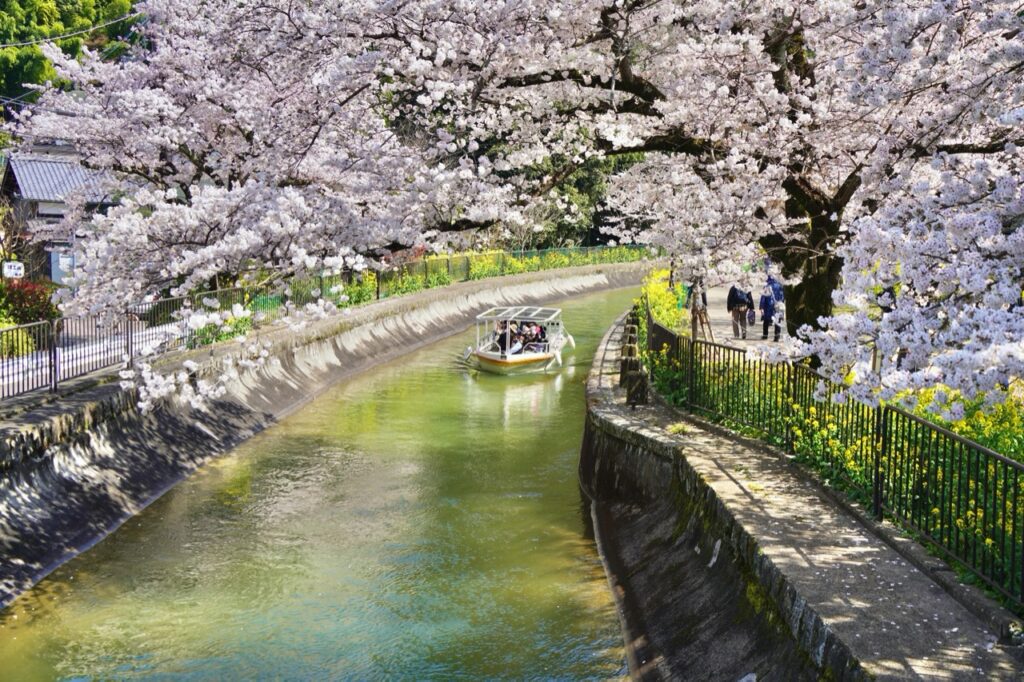

Best time to visit: Late March - early April
Hours: 8:00 - 15:00
Spring operating period / March 27, 2025 (Thursday) to June 8, 2025 (Sunday)
Fare/Otsu - Keage Adults 6,000 yen - 14,000 yen
*Fees for boarding for details areOfficial siteThan
Biwako Otsu Spring Lighting - Cherry Blossoms on Biwako Sosui
Period / Tuesday, March 25, 2025 - Sunday, April 13, 2025
Hours/18:00-21:30
Fee/No charge
Nijo Castle was built by Ieyasu Tokugawa and has been the setting for many historical events. In spring, visitors can enjoy a wide variety of cherry blossoms, starting with scarlet cherry trees, followed by someiyoshino cherry trees, mountain cherry trees, weeping cherry trees, and satozakura, a total of 300 cherry trees in 50 varieties. During the event period, the cherry blossoms are lit up at night and projection mapping is performed in the historical space.
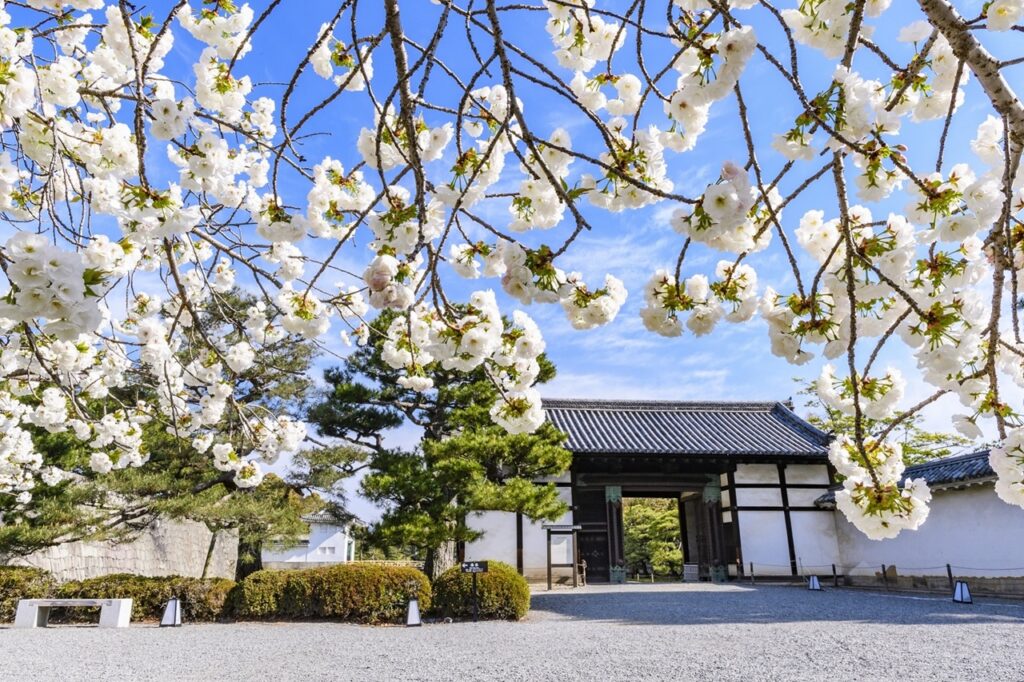

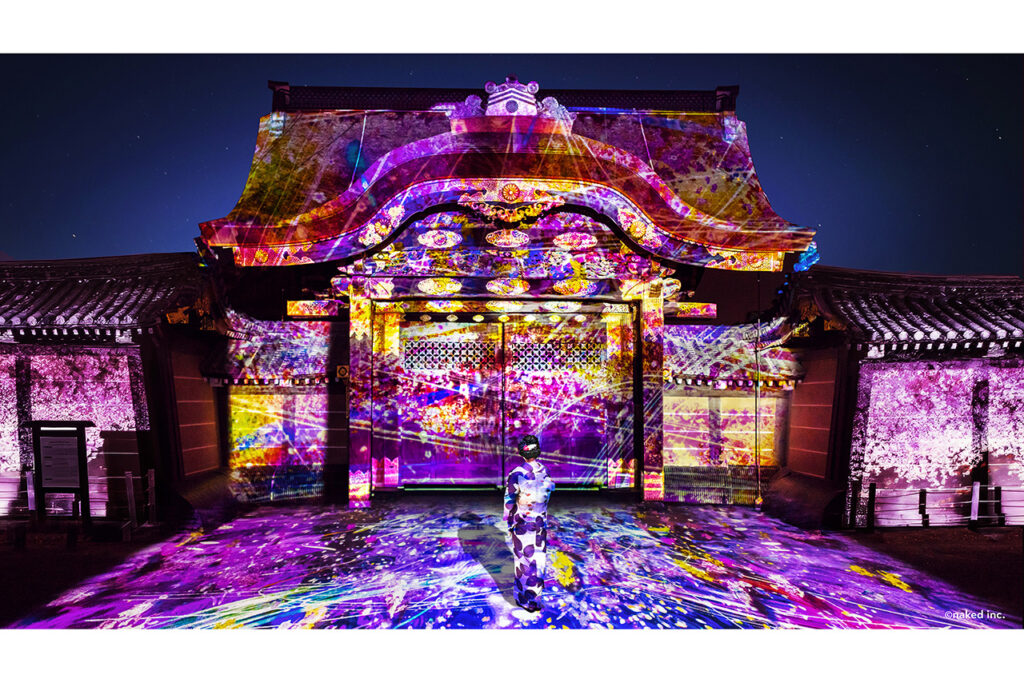
@naked inc.

Best time to visit: Mid-March to mid-April
Hours of admission/8:45-17:00 (last admission/16:00)
The Ninomaru Palace is open from 8:45 a.m. to 4:10 p.m.
Nijo Castle Cherry Blossom Festival 2025
Period / Friday, March 14, 2025 - Sunday, April 13, 2025
Hours/8:45-17:00 (last admission/16:00)
Admission: Adults 1,300 yen, junior high and high school students 400 yen, elementary school students 300 yen
Including admission to Ninomaru Palace
NAKED meets Nijo Castle 2025, Cherry Blossoms
Period / Friday, March 14, 20254 - Sunday, April 13, 20254
Time/18:00-22:00 (last admission/21:00)
Admission/Junior high school students and older: 2,000 yen, elementary school students: 1,000 yen on Monday through Thursday.
Friday-Sunday and holidays: 2,500 yen for junior high school students and older, 1,500 yen for elementary school students
*Purchase specific date tickets for March 22 (Sat), March 29 (Sat), April 5 (Sat), and April 12 (Sat). No admission with other tickets. Tickets for specific days are ¥2,800 for junior high school students and older, ¥1,800 for elementary school students.
[The Kyoto Gyoen (Kyoto Imperial Garden), which is now open to the public as a national park, was developed on the site of the former lord's town in the vicinity of the Kyoto Imperial Palace.]
The Kyoto Imperial Garden, rich in nature, is planted with approximately 1,000 cherry trees, including weeping cherry trees, Kurumagae cherry trees, and mountain cherry trees. The two most famous cherry trees are the "Izumi no edarezakura" and the "Chikamori no edarezakura. The early-blooming "Izumi no edarezakura" is a popular photo spot because of its beautiful shape, which resembles a spreading umbrella. From late March, about 60 weeping cherry trees (itozakura) at the Chikamori Estate bloom in a beautiful gradation of colors, from light to dark. (Blue sheets are not allowed).
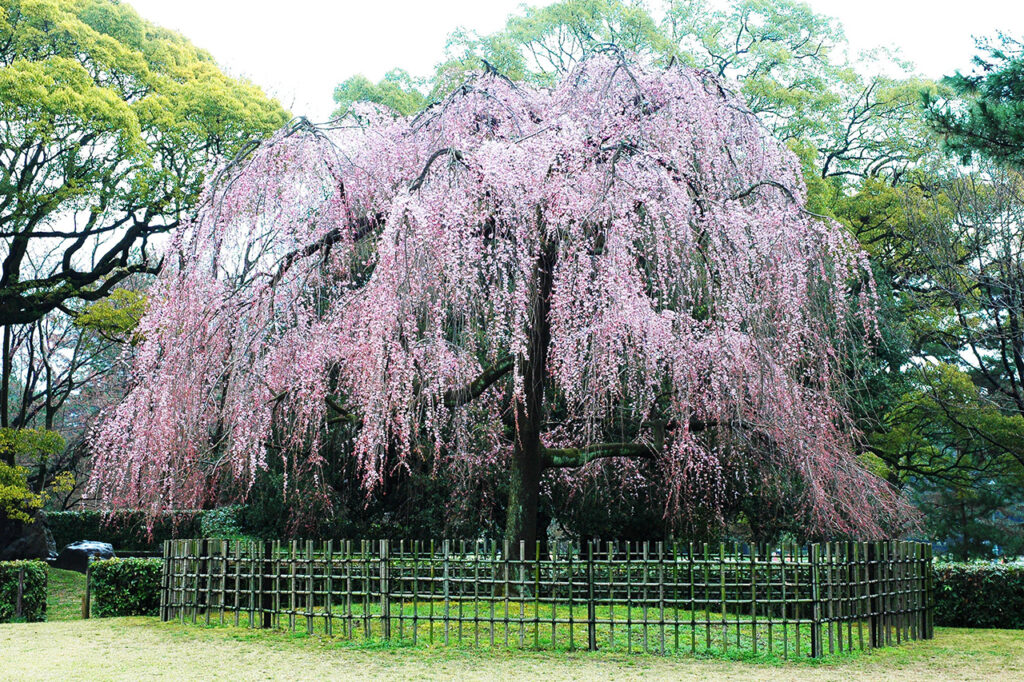
Image courtesy of Kyoto Gyoen Management Office, Ministry of the Environment

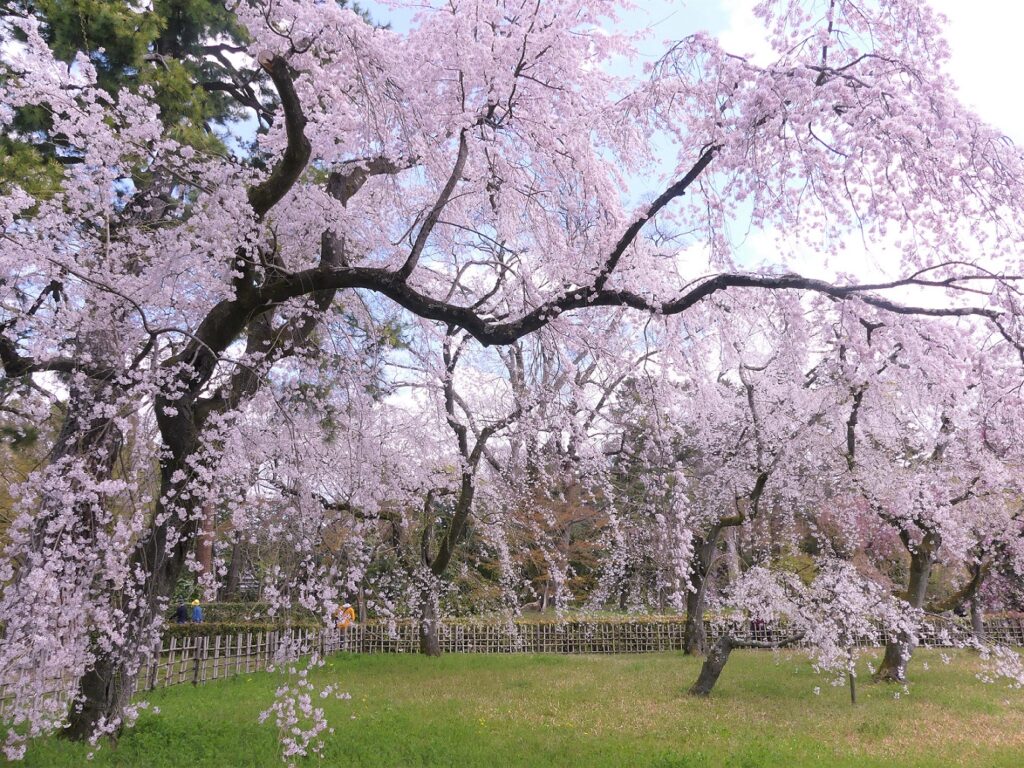
Image courtesy of Kyoto Gyoen Management Office, Ministry of the Environment

Best time to visit: Late March to mid-April
Admission Hours and Admission Fees / Admission to the park is free
Kamowakeikazuchi-jinja Shrine is one of the oldest shrines in Kyoto and is commonly known as Kamigamo Shrine.
The 150-year-old "Goshozakura" cherry tree, which opens its white blossoms in late March, and the "Saiozakura" cherry tree, a reddish-brown weeping cherry tree, line the side of the approach that stretches in a straight line from the first torii (first shrine gate) to the second torii (second shrine gate). The path leading to the second torii gate is lined with red-flowered miare-zakura (cherry blossom trees) and a variety of cherry blossoms with different origins and traditions.

(Photo courtesy of Kamigamo Shrine)



Best time to visit: mid-March to late April
Opening hours/5:30-17:00 (8:00-16:45 for the tower gate and the awarding office)
Admission fee/free
[The Hanmoku-no-michi is a walking path on the west side of the Kyoto Botanical Garden. Along the Kamo River from Kitayama Ohashi Bridge to Kitaoji Bridge, double-stemmed weeping cherry trees create a tunnel of cherry blossoms that stretches for about 800 meters. From near Aoi Bridge to near Kamigamo Bridge, there is a row of Someiyoshino cherry trees, and the view from the other side of the river is beautiful.
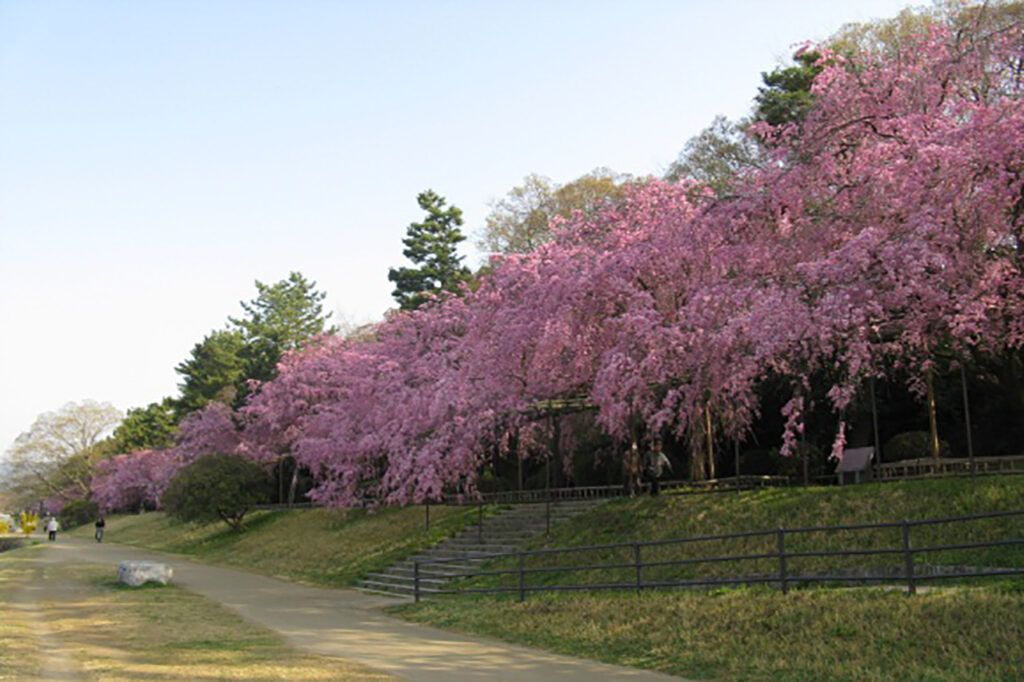

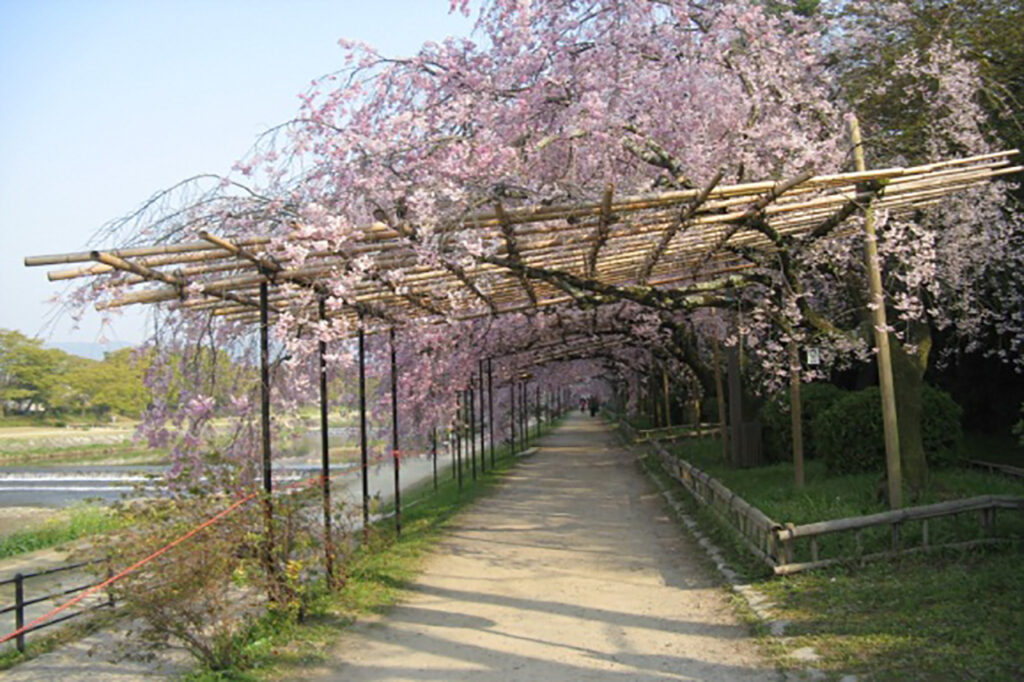

Best time to visit: Early to mid-April
free to stroll (i.e. to take a stroll)
Hirano Shrine is famous for its cherry blossoms, known as "Hirano no Yozakura (night cherry blossoms). About 400 cherry trees of about 60 varieties are planted on the shrine grounds, including many rare varieties that originated in this area. The early-blooming weeping cherry "Kai-zakura" and other cherry trees bloom at different times, so visitors can enjoy viewing cherry blossoms over a long period of time. During the special nighttime illumination, visitors can enjoy the fantastic scenery of the cherry blossom garden and grounds illuminated by lights such as bonbori (paper lanterns) and lanterns.


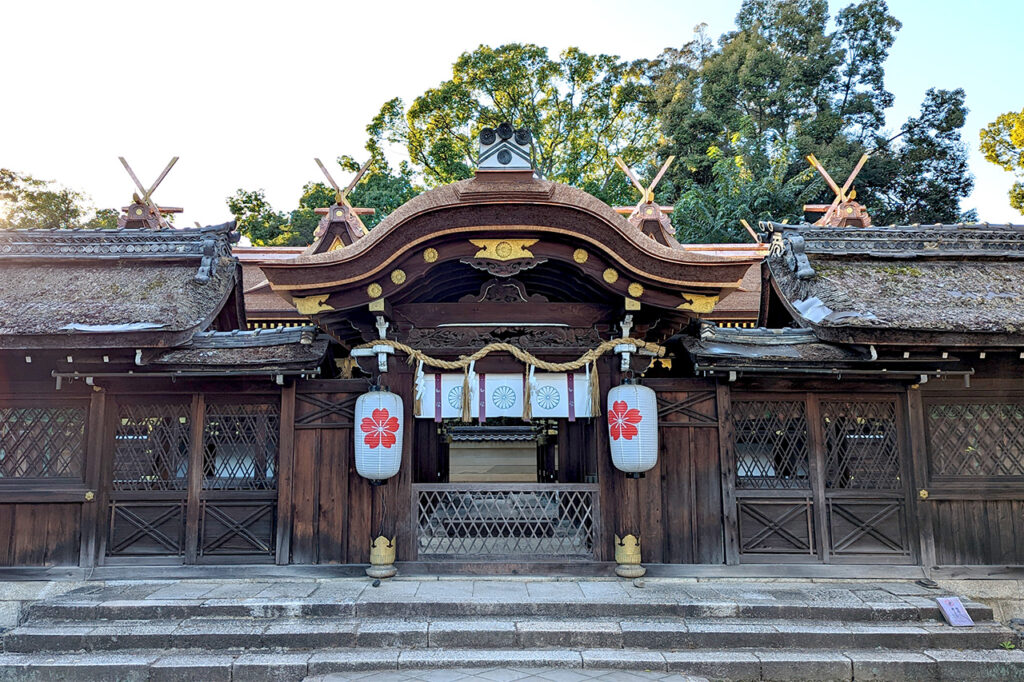

Best time to visit: Late March to mid-April
Hours of worship/6:00-17:00
Hirano Shrine Night Cherry Blossom Special Visit
Period / Saturday, March 22, 2025 - Sunday, April 13, 2025
Hours: Sunset - 21:00
Admission: Free (some sections charge a fee)
Ninna-ji Temple has long been associated with the Imperial Family, and its abbot is a former member of the Imperial Family. In addition to someiyoshino cherry trees in front of Kondo Hall and yodow cherry trees in front of Kannondō Hall, about 200 late-blooming "Omuro-zakura" cherry trees, known as a synonym for Ninna-ji Temple, bloom in early to mid April in the cherry garden. The contrast between the elegant architecture and the cherry blossoms is a breathtaking sight. There are also many azaleas and rhododendrons on the temple grounds, allowing visitors to take their time and savor the spring scenery.
-1024x682.jpg)
Ninna-ji Omuro Cherry Blossom, Goten, North Garden (Photo by Sohonzan Ninna-ji Temple)

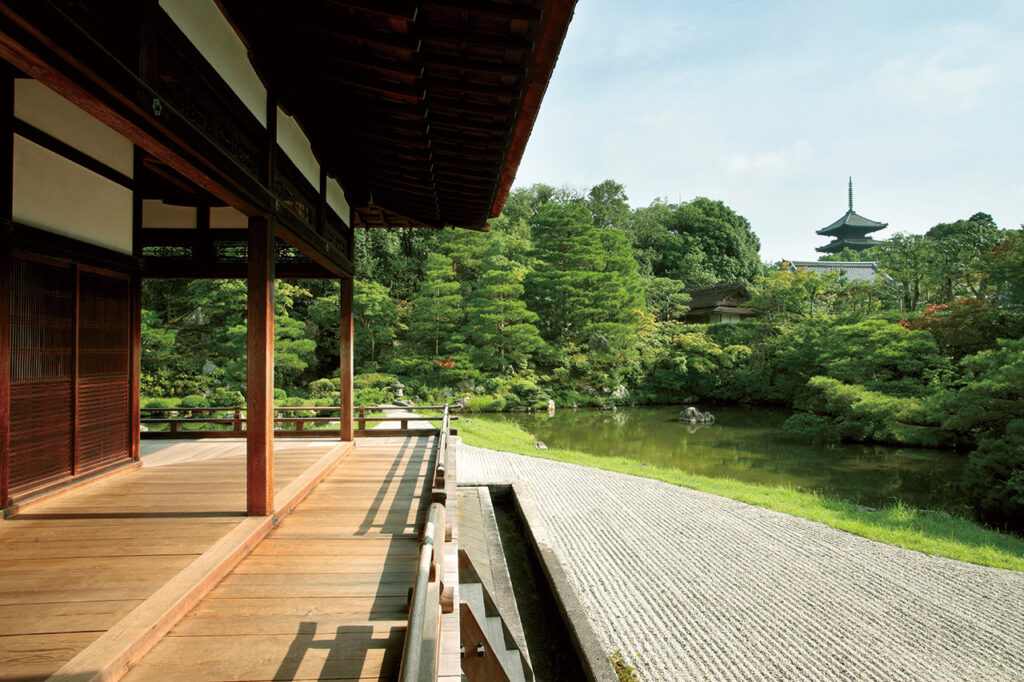

Best time to visit: Early to mid-April
Hours * Ninna-ji Gosho Garden / Mar-Nov 9:00-17:00, Dec-Feb 9:00-16:30
Admission: Gosho Garden, 800 yen for adults, free for high school students and younger
[The Myoshin-ji Temple Tenzoin is located just west of the south main gate of Myoshin-ji Temple. It is famous for its red weeping cherry tree, which was planted about 50 years ago when the famous garden, Yokoen, was completed. [The petals change color in gradations as the days go by. When the petals fall, a shower of cherry blossoms is like a shower of snowflakes, which is also a beautiful sight to behold.
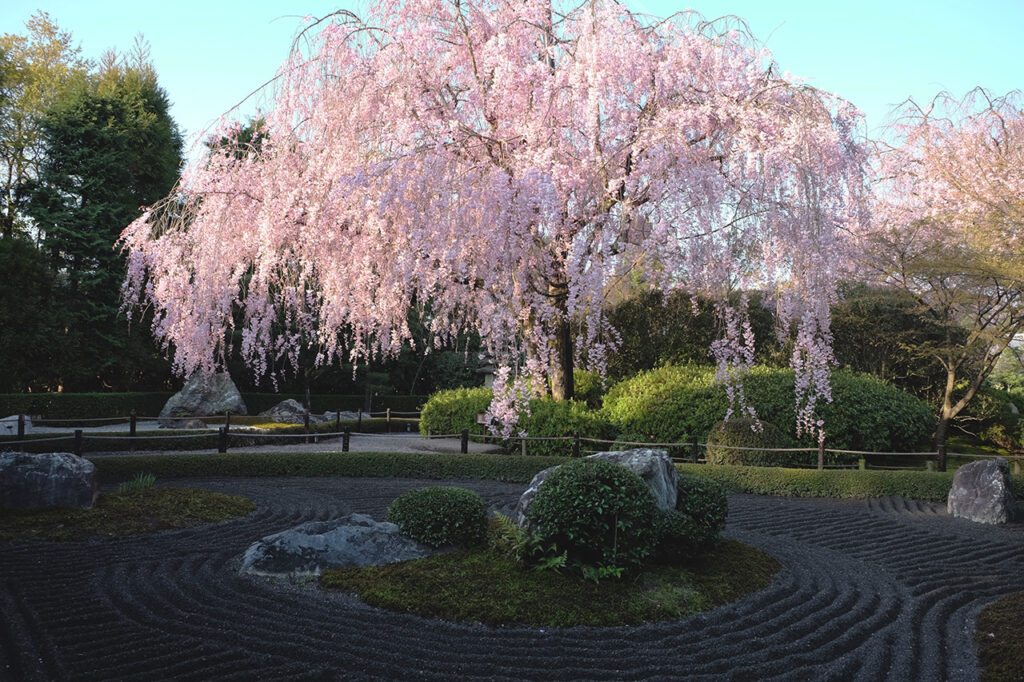
Image courtesy of Myoshinji Temple Pagoda [Tazo-in]

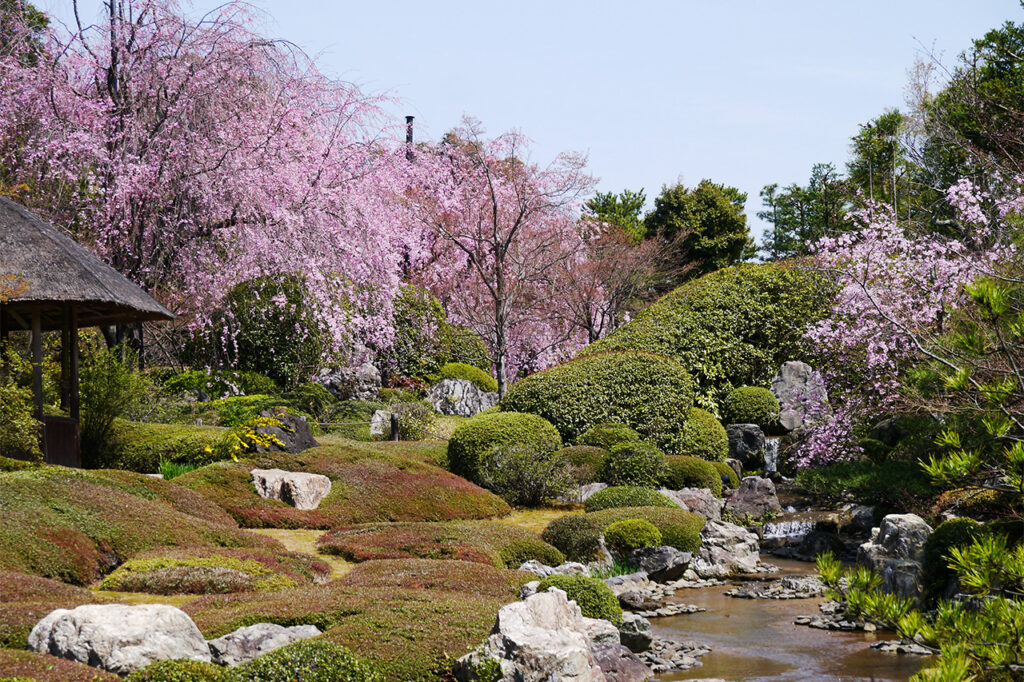
Image courtesy of Myoshinji Temple Pagoda [Tazo-in]

Best time to visit: Late March - early April
Visiting hours/9:00-17:00 (last reception)
Admission: 600 yen for adults, 300 yen for elementary and junior high school students (free for preschool children)
Matcha green tea (with sweets) 700 yen
Ryoan-ji Temple is famous for its dry landscape garden called Hojo Teien, which expresses the beauty of Zen. In addition to the weeping cherry trees peeking out from behind the walls of the Hojo Teien, a dry landscape stone garden, the mountain cherry trees and someiyoshino cherry trees reflected on the surface of the water of Kagayoike, a garden with a circular garden with a pond, are in beautiful bloom. During the blooming season, approximately 400 cherry trees adorn the grounds of the temple, and visitors can enjoy the cherry blossom garden.
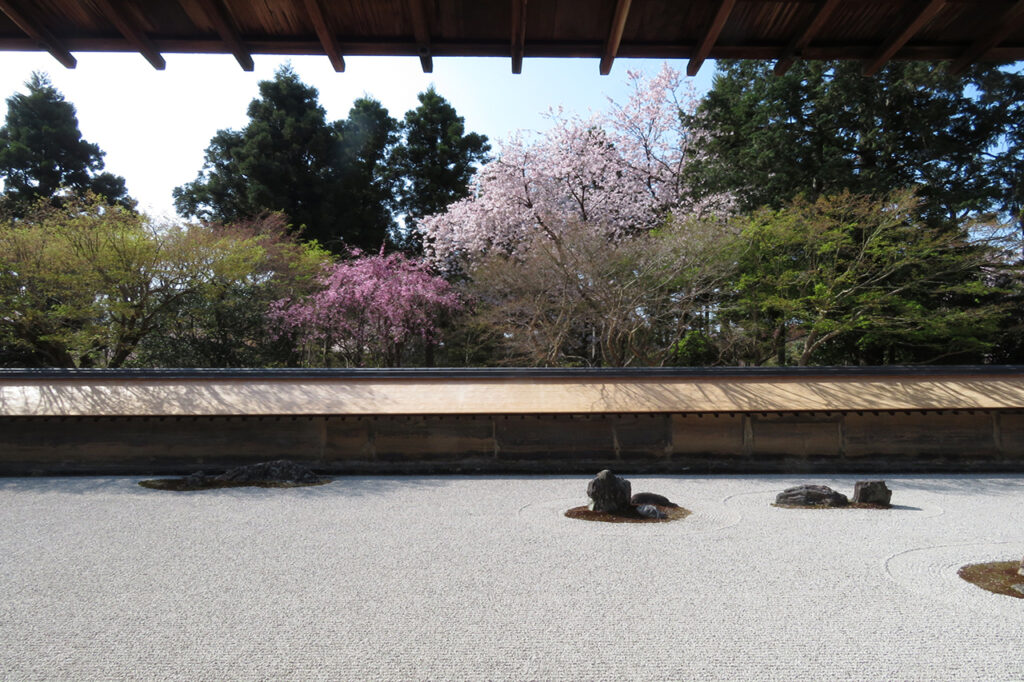
Image courtesy of Ryoanji Temple

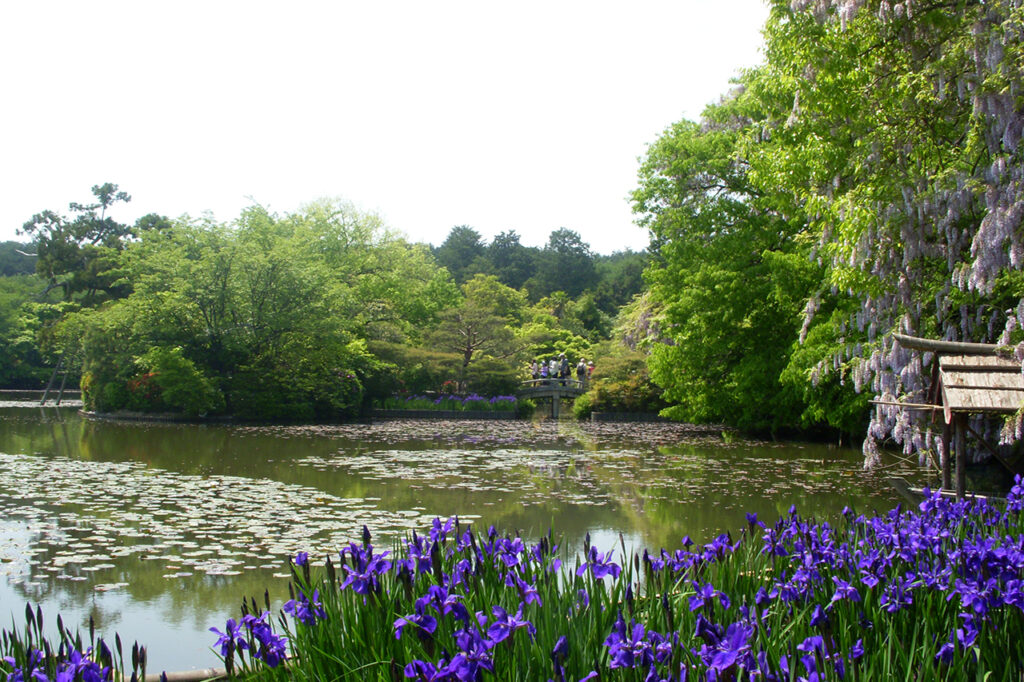
Image courtesy of Ryoanji Temple

Best time to visit: Late March - early April
Hours of visitation / 8:00-17:00, 8:30-16:30 from December to February.
Admission: Adults 600 yen, High school students 500 yen, Elementary and junior high school students 300 yen
Kurumaori Shrine is dedicated to Kiyohara Yoriyoshi, a Confucian scholar of the Heian period. The shrine has a strong connection with cherry blossoms, as there is an anecdote that Kiyohara Yoriyoshi was a great admirer of cherry blossoms during his lifetime. The shrine has 40 cherry trees of about 15 varieties, including Kawazu cherry, scarlet cherry, Keisen cherry, and Yohkoh cherry, which can be enjoyed over a long period of time from early March to late April.
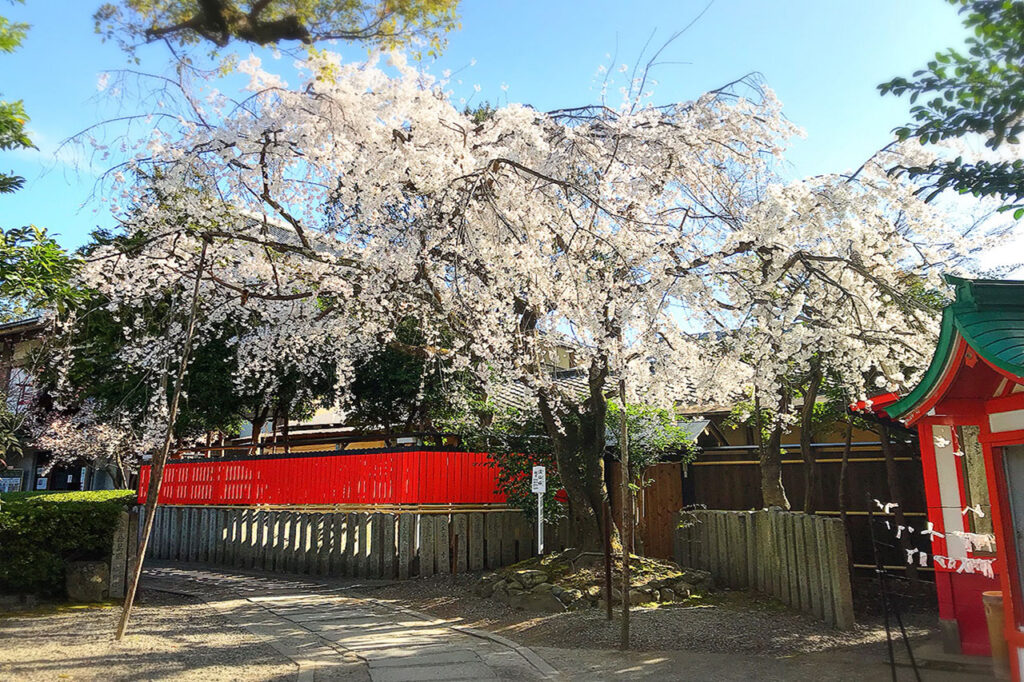

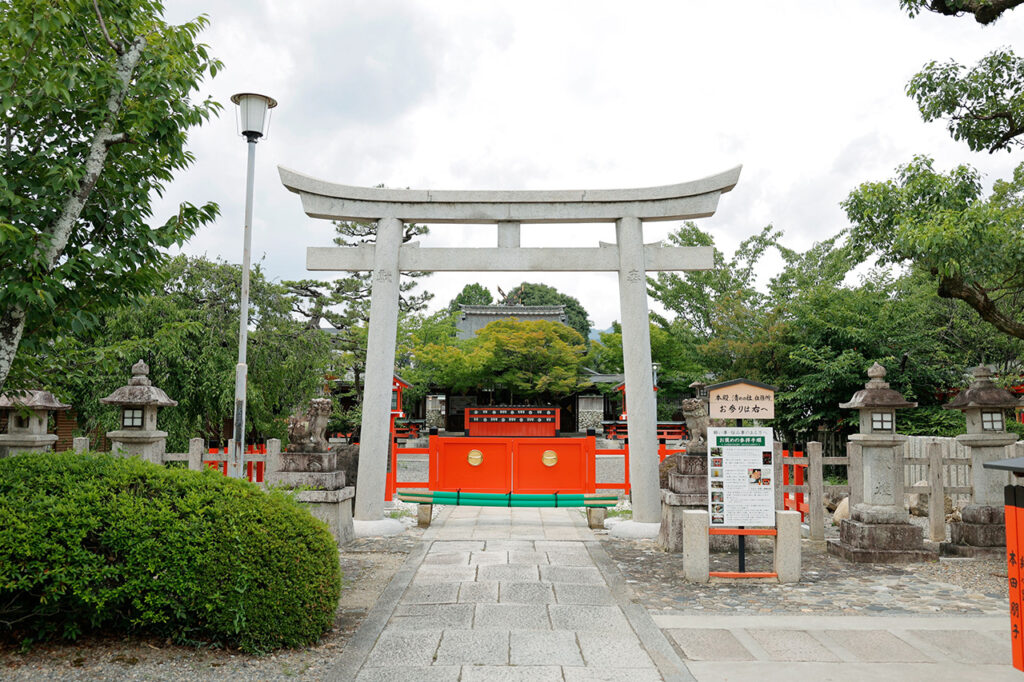

Best time to visit: Early March to late April
Hours of visitation/9:30-17:00
Entrance fee/free in the precincts
Daikakuji Temple is the head temple of the Daikakuji School of Shingon Buddhism and is also famous as the birthplace of ikebana, the art of flower arrangement. In the hall area, the highlight is the red weeping cherry tree blooming next to the imperial envoy gate on the south front side of the Shingyozen-den Hall. In the Osawa Pond area to the east, about 500 cherry trees, including Someiyoshino and mountain cherry trees, are planted. Take a walk around the vast pond and enjoy the spectacular view of the cherry blossoms and the sky reflected like a mirror on the surface of the water.
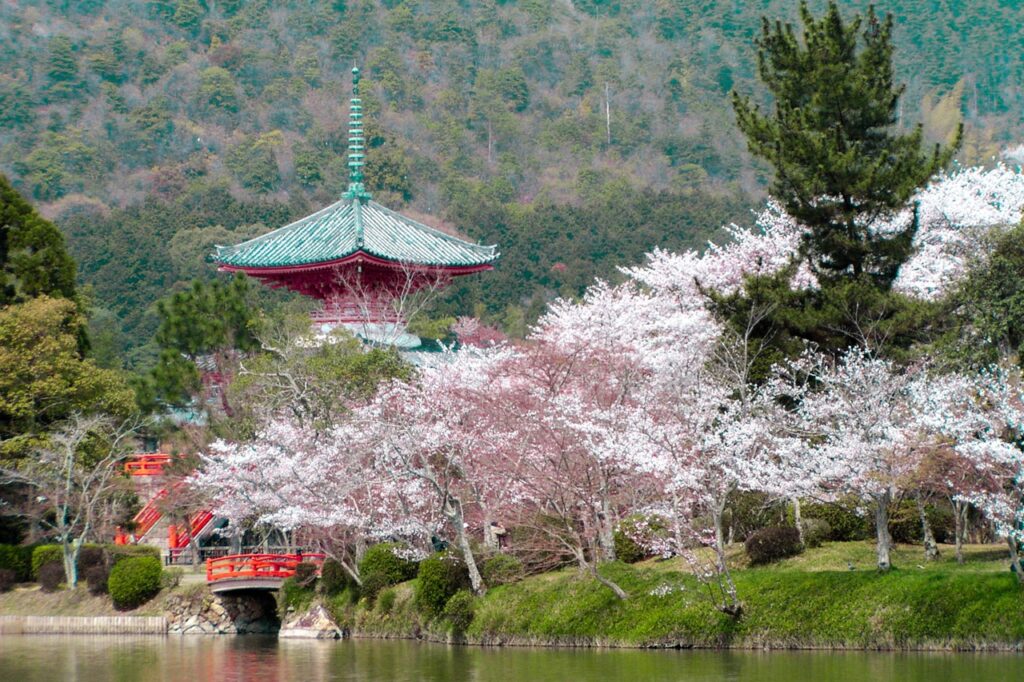

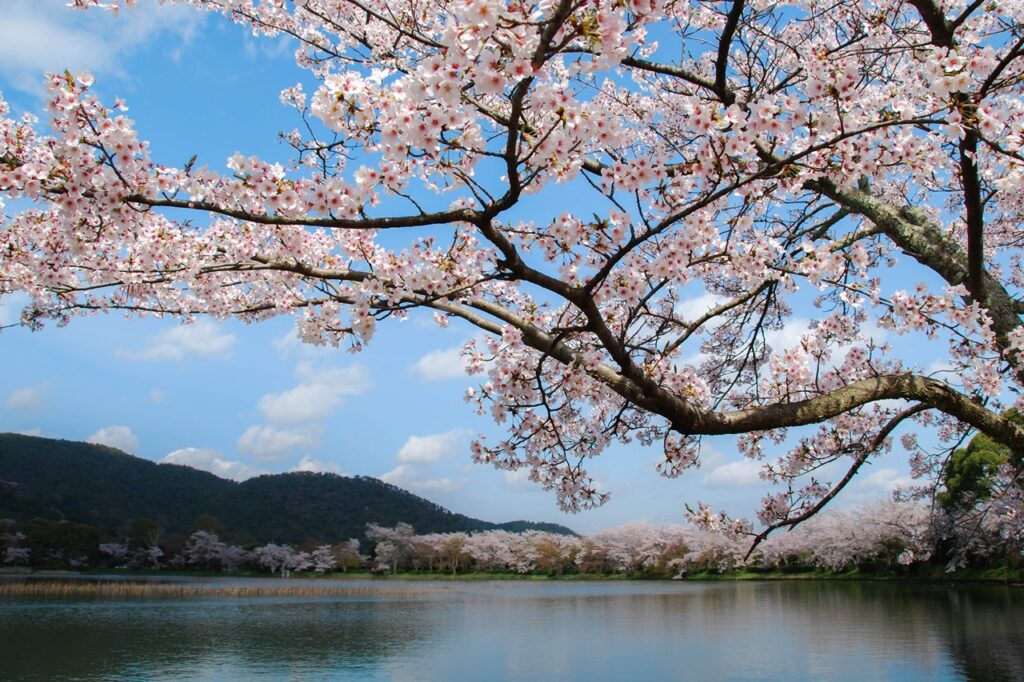

Usually around mid-April *Varies depending on the weather.
Visiting hours/9:00-17:00 (Last entry/16:30)
Admission/ Adults 500 yen, elementary, junior high and high school students 300 yen *Adults 300 yen, elementary, junior high and high school students 100 yen for Oosawaike Pond area
The Arashiyama area is steeped in history and nature, with numerous poets captivated by its beauty and composing poems about it, and it is also mentioned in "The Tale of Genji".
[From the Watarigetsukyo Bridge, you can enjoy a spectacular view of the beautiful blooming cherry trees along the Katsura River and in the Nakanoshima area of Arashiyama Park, with Arashiyama in the background. Find your favorite view by strolling along the paths along the river or viewing from the water of Katsura River.
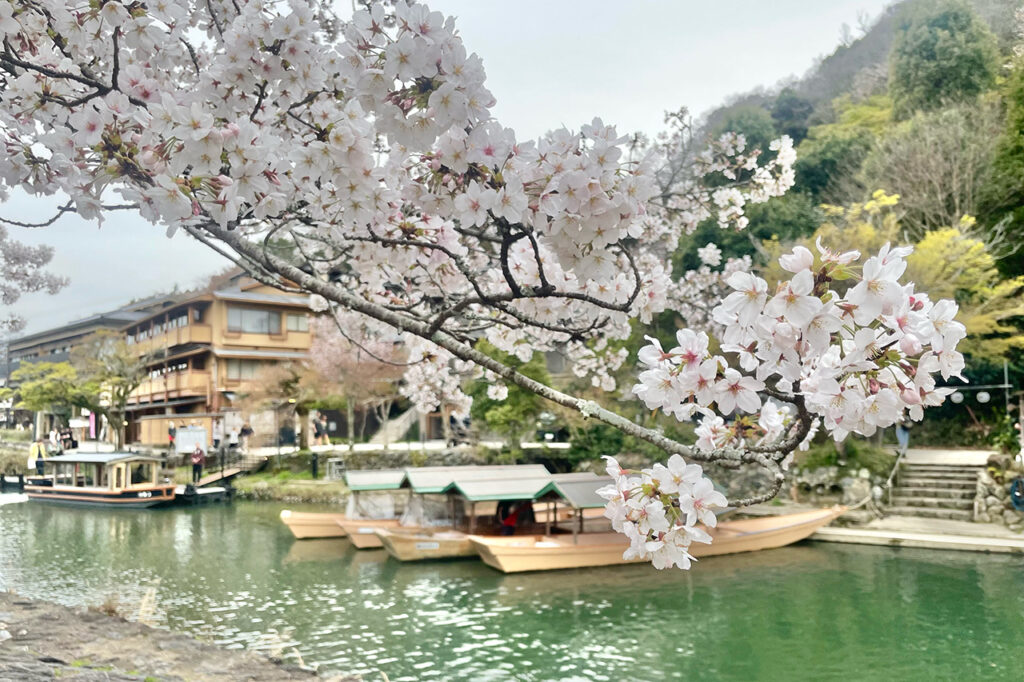



Tenryuji Temple was founded in 1339 by Ashikaga Takauji to mourn the loss of Emperor Godaigo. The Sogen Pond Garden, the first garden in Japan to be designated as a historic site and a special place of scenic beauty, was created by the monk Muso Kunishi about 700 years ago, and is surrounded by approximately 200 cherry trees, including weeping cherry trees, someiyoshino cherry trees, and mountain cherry trees. From "Mangyo-no-oka," a hill on the west side of Tahouden Hall, you can enjoy a panoramic view of Kyoto City along with the cherry blossoms on the temple grounds, which is also a must-see.


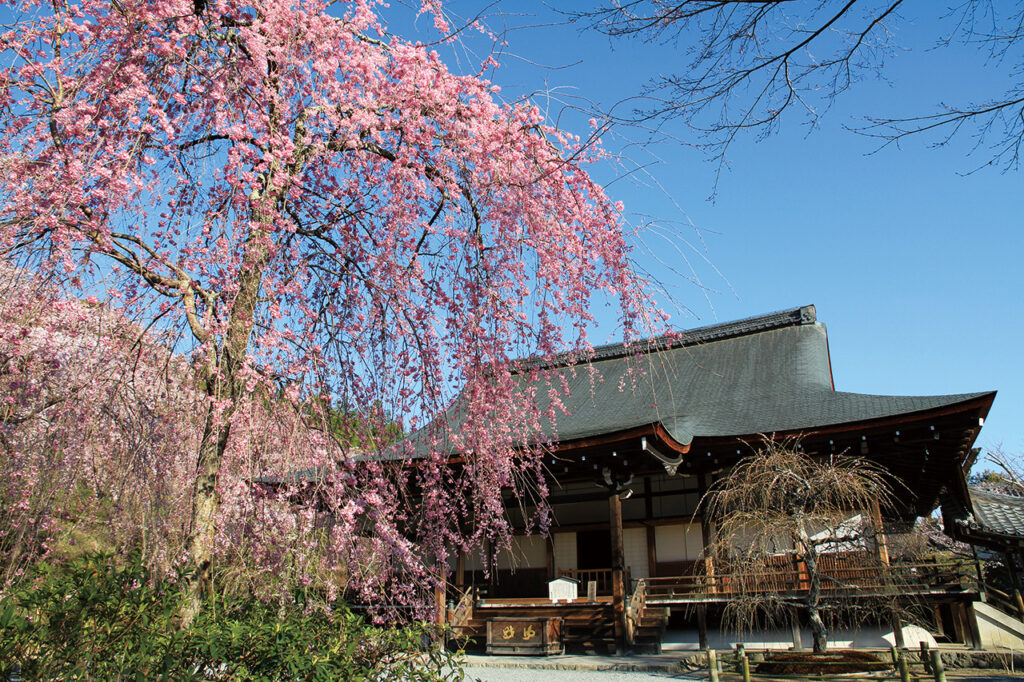

Best time to visit: Late March to mid-April
Hours: 8:30 - 17:00 (reception ends at 16:50)
Halls 8:30-16:45 (reception closes at 16:30)
Unryuzu" in the Dharma Hall is open to the public only on Saturdays, Sundays, and national holidays from 9:00 to 16:30 (reception closes at 16:20).
Open to the public every day in spring and fall.
Cherry Blossom Viewing Party" (Nodate seating)
Period / Wednesday, April 2, 2025
Time/10:00-15:00
Admission: 500 yen for high school students and older, 300 yen for elementary and junior high school students, and 800 yen for powdered green tea.
Sanzen-in Temple has a 1200 year history as one of the Gokashitsu-monzeki of the Tendai sect of Buddhism. Located in Ohara, where the cherry blossoms bloom a little later than in Kyoto City, it is the perfect place to enjoy the late-blooming cherry blossoms. Visitors are greeted by beautiful weeping cherry trees at the stone-walled entrance, Gotenmon Gate, and the view of the garden decorated with cherry blossoms and rhododendrons is not to be missed. Every year in April, the Fudo Grand Festival is held for a month, during which visitors can view the hidden statue of Konjon Fudo Myoo, the Golden Buddha.
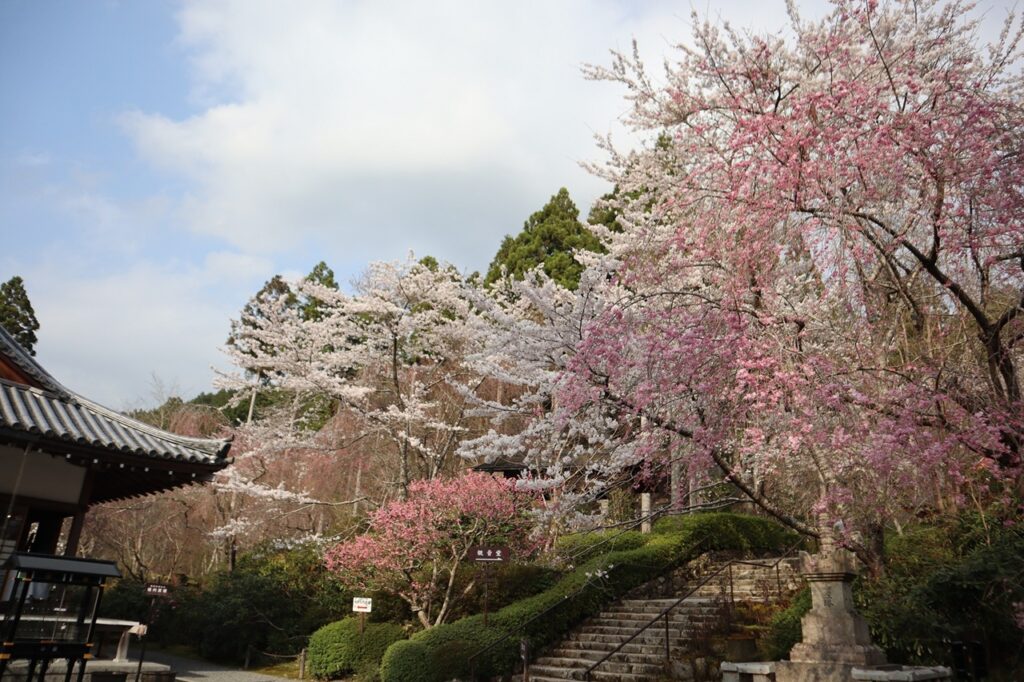

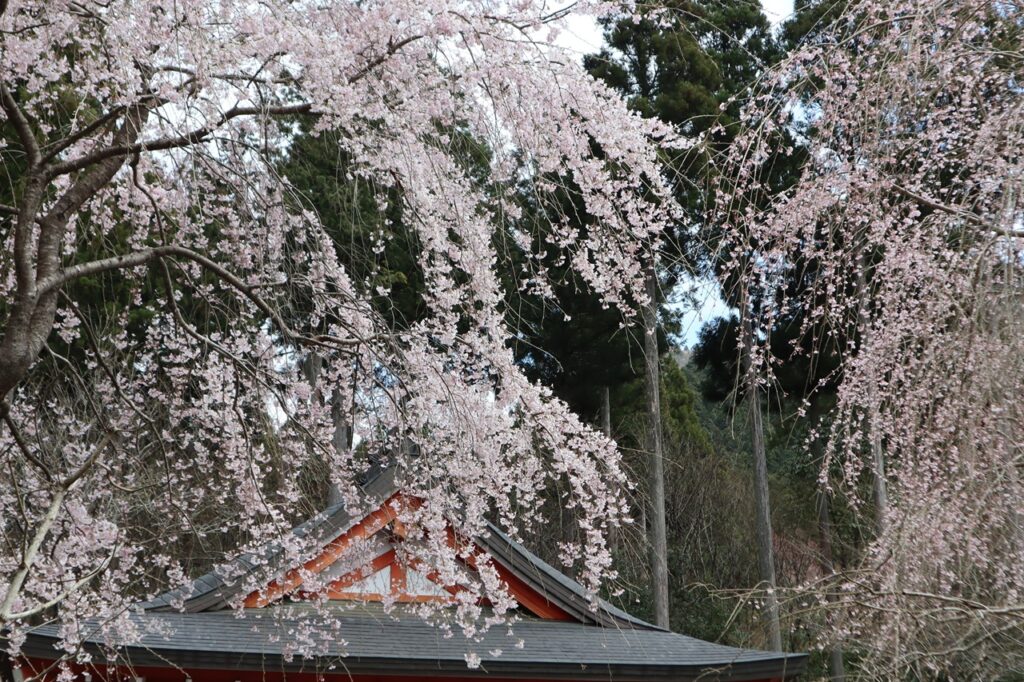

Best time to visit: Mid-April
Hours of visitation/9:00-17:00 (March-October)
Admission: Adults 700 yen, junior high and high school students 400 yen, elementary school students 150 yen
Fudo Grand Festival, the opening of the door to the hidden Buddha, Konjikin Fudo Myoo.
Period / Saturday, April 19, 2025 - Sunday, May 18, 2025
Hours: 9:00 - 17:00 (Registration closes at 16:30)
Admission fee/700 yen
Philosophers and literary figures strolled along this path, hence the name [Philosophical Path].
The 2-km-long walking path along the Sosui that runs from Wakaoji-bashi Bridge to Jodoji-bashi Bridge has been selected as one of the "100 best paths in Japan. About 400 Someiyoshino cherry trees and others are planted along both banks of the Sosui, and when they are in full bloom, it looks like a tunnel of cherry blossoms.
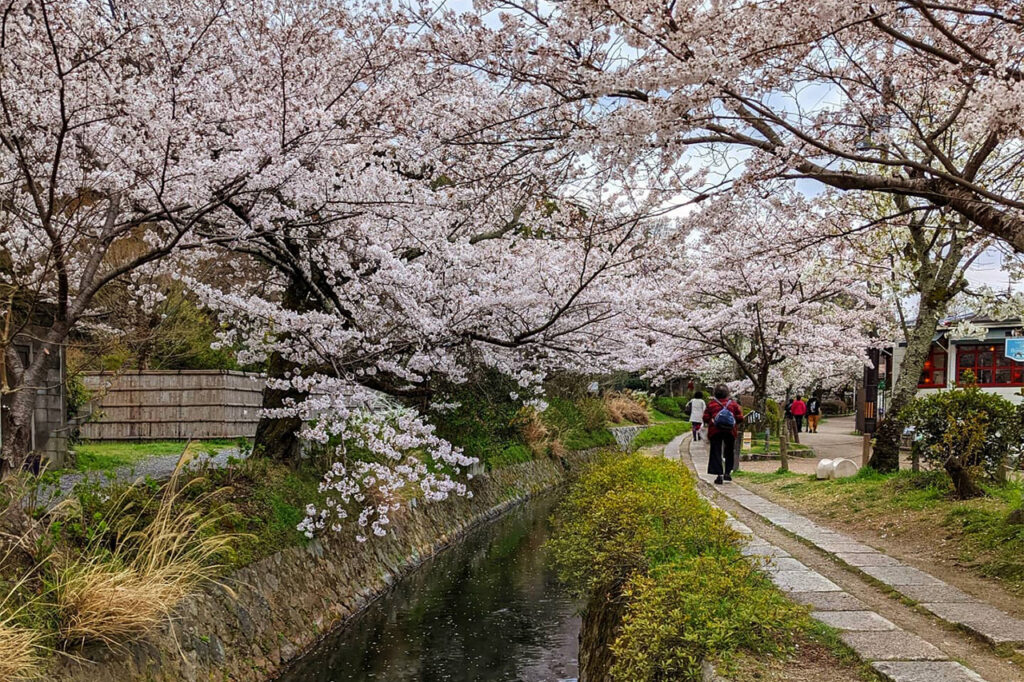

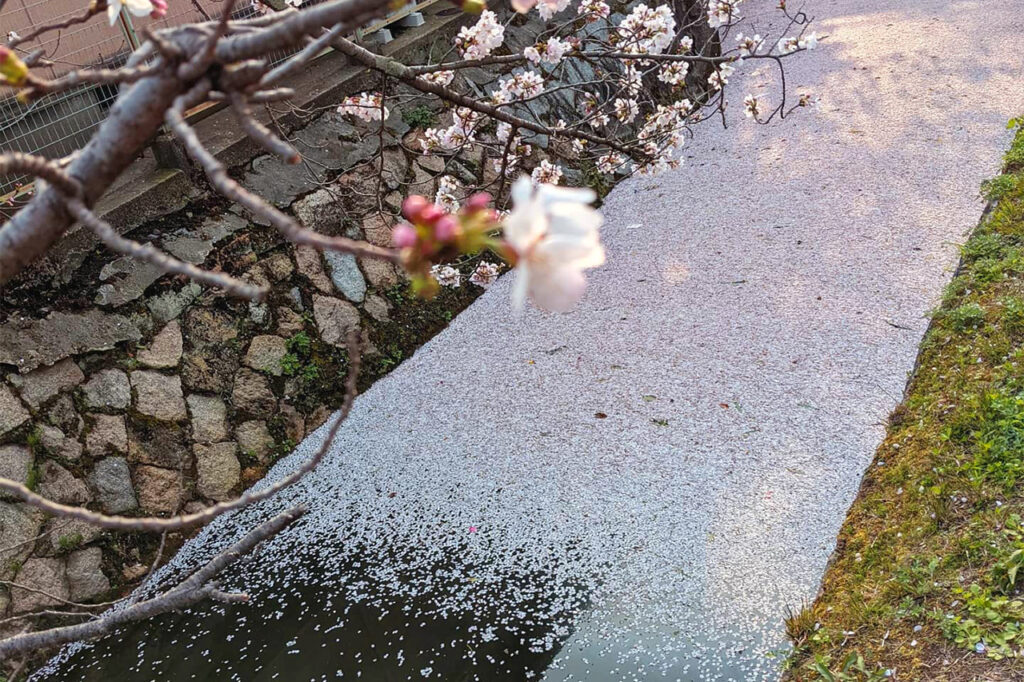

Best time to visit: Late March - early April
free to observe
The Fushimi Juseki-Bune is a recreation of a transport boat that carried sake, rice, and passengers on the Yodo River during the Edo period (1603-1868).
It is a 50-minute round trip along the Uji River, which at that time was lined with wholesale stores and sake breweries. During the cherry blossom season, visitors can leisurely enjoy the 1km-long row of more than 100 cherry trees, and at night, the reflection of the cherry blossoms on the river surface is a spectacular sight.
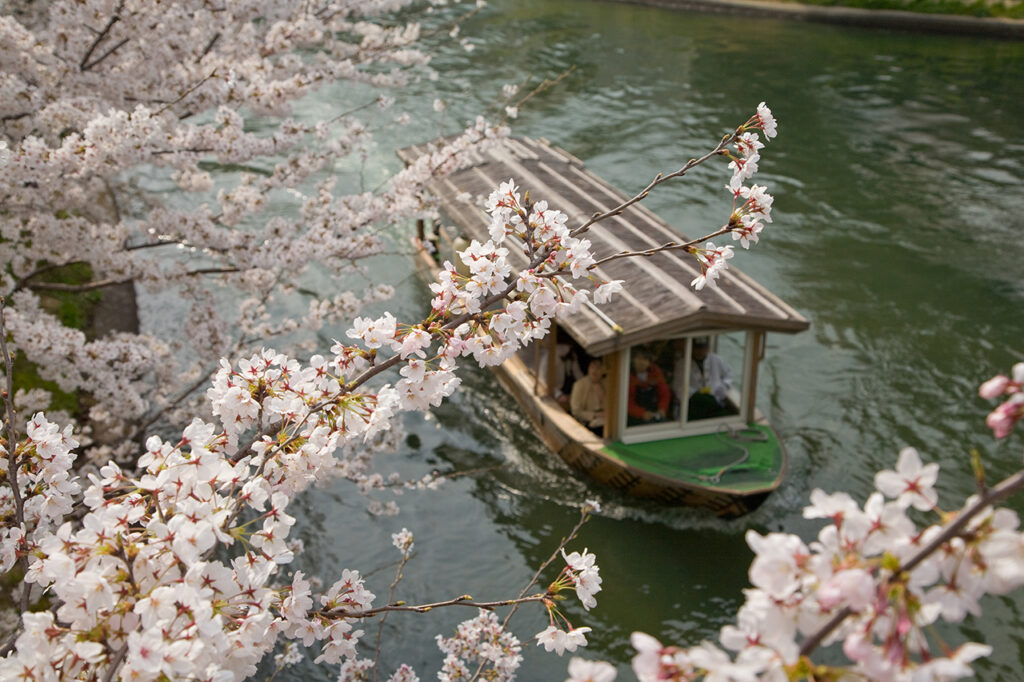

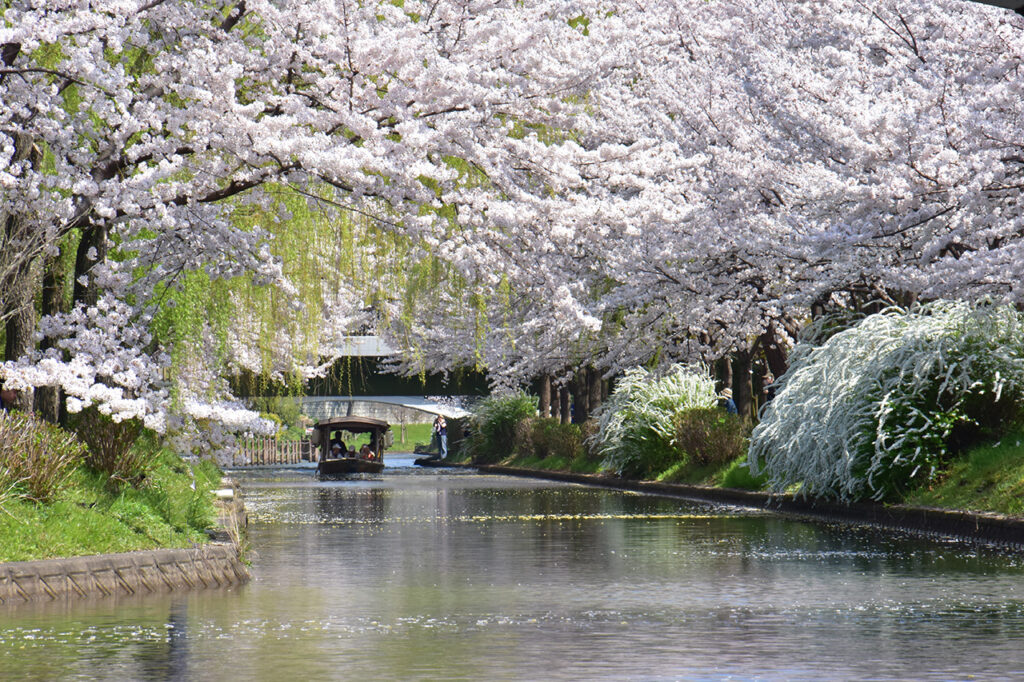

Best time to visit: Late March - early April
Fushimi Jusekifune
Period / March 20, 2025 (Thursday, national holiday)
Closed/Mondays (except holidays, Mondays in April, May, October, and November), closed from August 12 (Tuesday) to August 31 (Sunday), 2025
Time/10:00~16:20
Fee/Junior high school students and older: 1,900 yen, elementary school students and younger: 900 yen
Reservations: Until midnight 2 days prior to the desired date of embarkation
Capacity/20 persons
Jonan-gu Shrine was built to protect the capital and the country when the capital was relocated to Heian period (794-1192), and is widely worshipped as a god of protection from the elements. In spring, dark crimson weeping cherry trees bloom in Raku-suien Garden, a Shinto garden popularly known as the "Flower Garden of the Tale of Genji," and beautiful cherry blossom views can be seen against the green lawn from Muromachi Garden, Momoyama Garden, and Jonan Detached Palace Garden. Enjoy the elegant atmosphere while thinking about the ancient aristocratic culture.
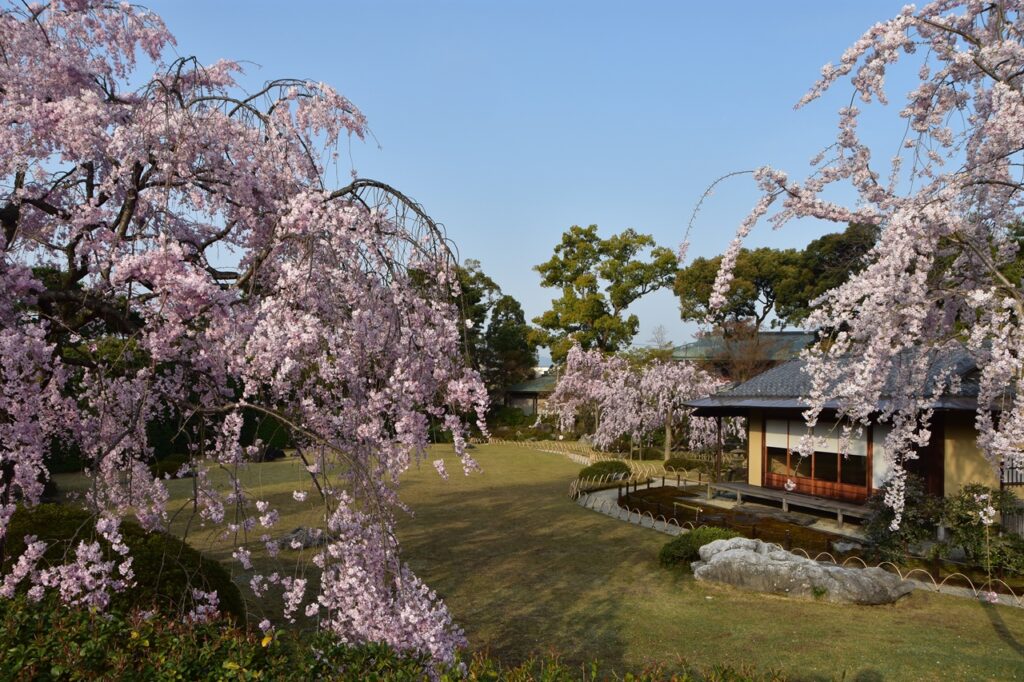



Best time to visit: Mid-April
Hours: 9:00-16:30 (last admission at 16:00)
Admission/ Adults 800 yen, Elementary school students 500 yen *Varies depending on the period of the year.
Daigoji Temple, where Toyotomi Hideyoshi is said to have held his Daigo cherry blossom viewing party, is a famous cherry blossom viewing spot also known as "Hana-no-Daigo. About 700 cherry trees, including weeping cherry trees, someiyoshino cherry trees, mountain cherry trees, and double-flowered cherry trees, are in full bloom one after another, making cherry blossom viewing enjoyable over a long period of time. Every year, the Reihokan, which houses many cultural properties, holds a special spring exhibition, in which temple treasures are exhibited according to a theme from among approximately 75,000 national treasures and 430 important cultural properties.
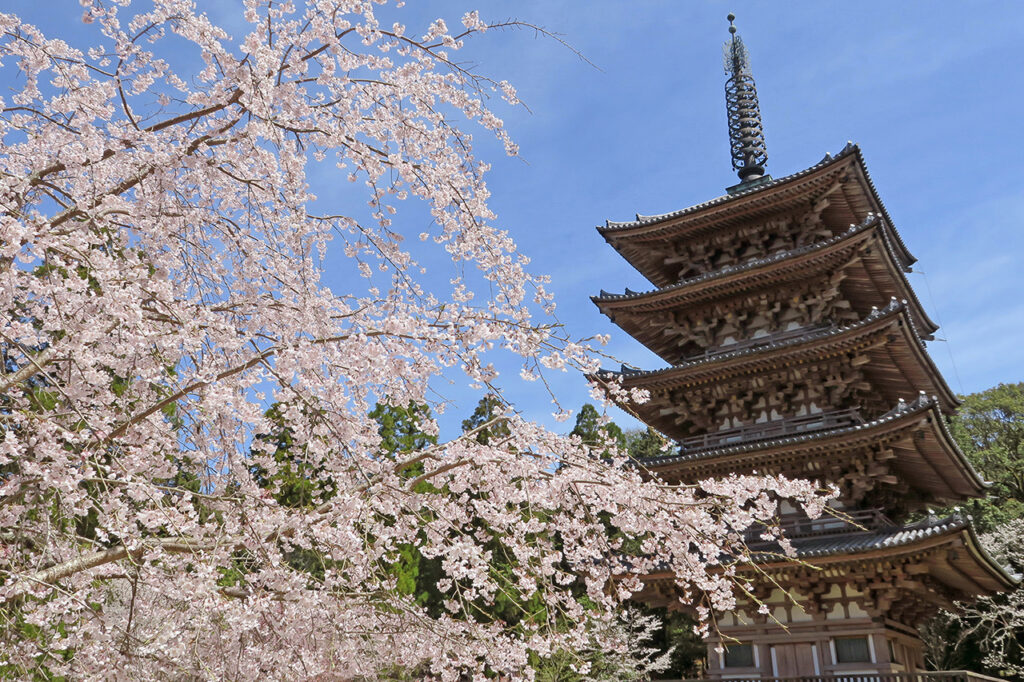

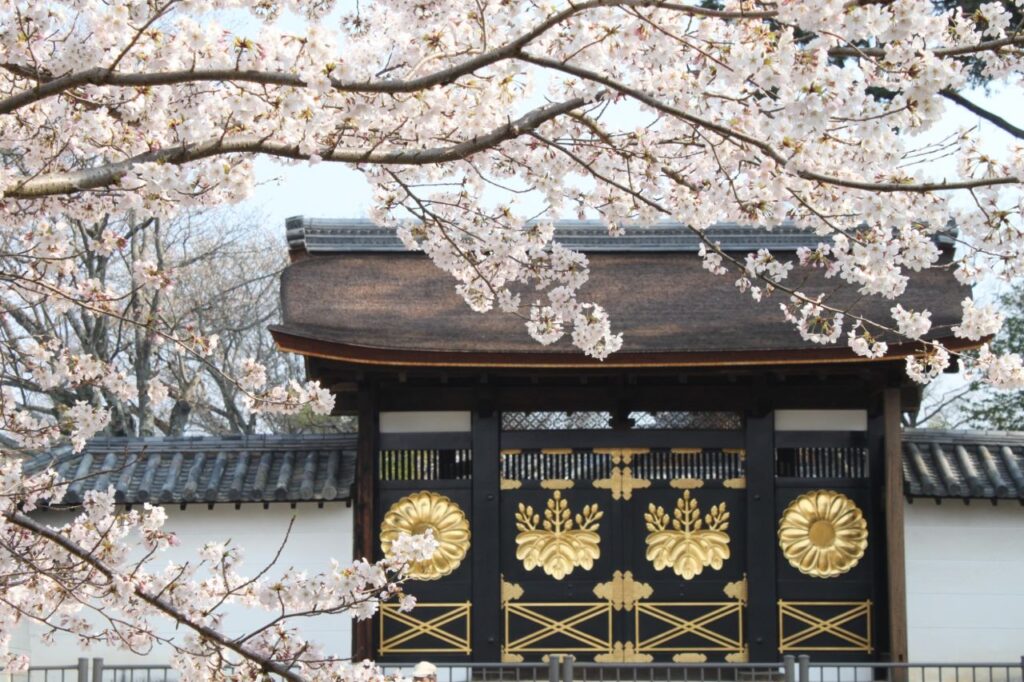

Best time to visit: Late March - early April
Visiting hours/9:00-17:00 (Last entry/16:30)
Admission/Three-entrance ticket (Sanboin, Garan, Reihokan) is ¥1,800 for adults and ¥1,300 for junior high and high school students from March 20 (Thu., holiday) to April 20 (Sun.), 2025. 1-entrance ticket is ¥800 for adults and ¥600 for junior high and high school students.
Sanboin special view is 500 yen for junior high school students and older; admission to Kami-Daigo is free.
Reihokan Spring Special Exhibition "The 90th Anniversary of the Daigoji Reihokan: Temple Treasures Passed Down from Generations to Generations
Bishamondo, a temple affiliated with the Tendai sect of Buddhism, is named after its principal deity, Bishamonten, who is enshrined in the temple's main sanctuary. The temple is widely known for its cherry blossoms as well as for its autumn foliage, and many visitors come to see the cherry blossoms every year. In particular, the weeping cherry tree in front of Shinkinden Hall, also called "Bishamon Shidare," is said to be over 150 years old. With branches reaching 30 meters in length, its imposing appearance is sure to impress. In addition, more than 80 cherry trees are in full bloom in the precincts of the temple, and the area around the main hall, the storehouse of Buddhist scriptures, and the Teshimon Gate are dappled with a light color.
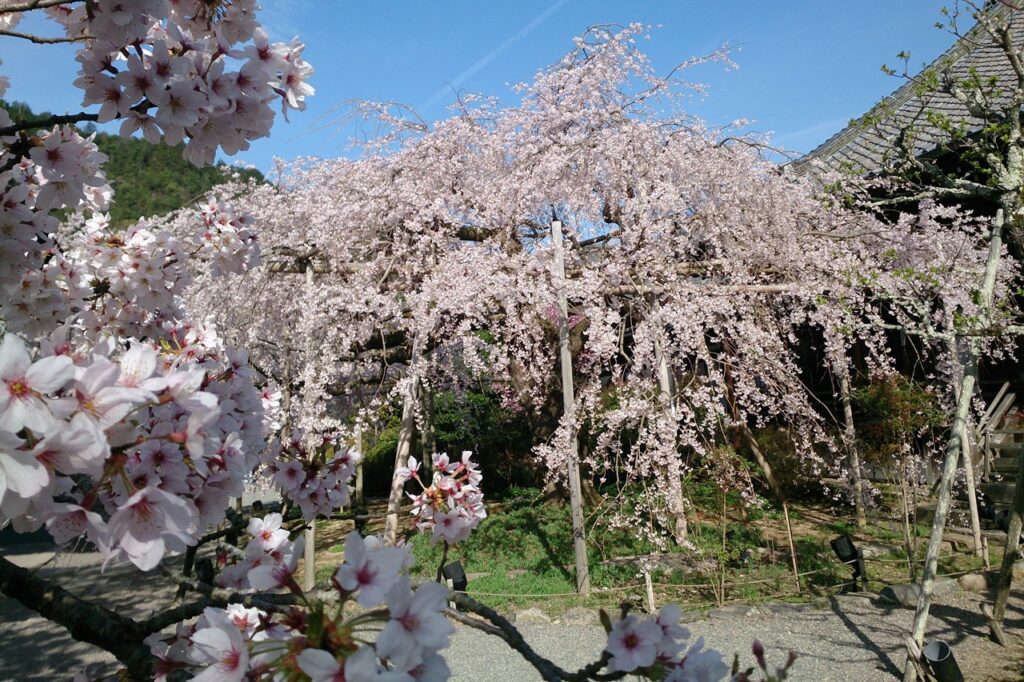

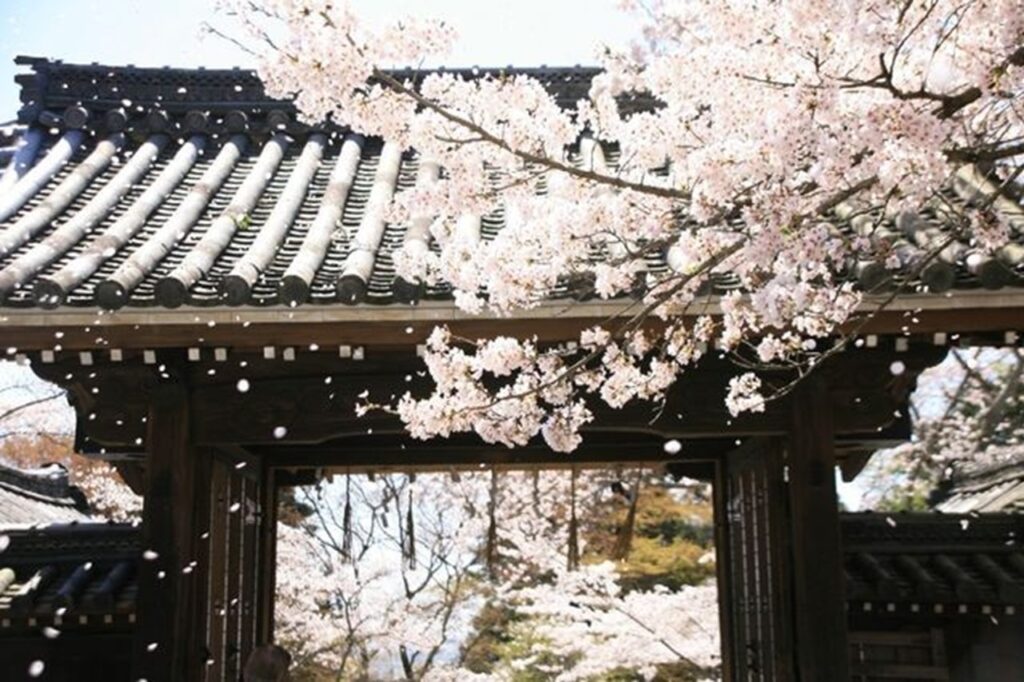

Best time to visit: Late March - early April *Varies depending on the weather.
Hours: March-November 9:00-16:00 (last admission at 16:30)
Admission: Adults 700 yen, High school students 400 yen, Elementary and junior high school students 300 yen
Byodoin Temple was originally a villa of Fujiwara no Michinaga, which was converted into a temple by Fujiwara no Yorimichi. In the precincts of the temple, weeping cherry trees and someiyoshino cherry trees that bloom early in the season are in full bloom in turn, and the spring scenery can be enjoyed. The cherry blossoms against the backdrop of the Phoenix Hall and the Aji Pond are so beautiful that you will want to capture them with your camera.

Photo courtesy of Byodoin Temple

Best time to visit: Late March - early April
Garden viewing hours: 8:30-17:30 (last admission at 17:15) *From Tuesday, April 1, 2025, 8:45-17:30 (last admission at 17:15)
Ho-oh-do interior viewing hours/9:30-16:10 (every 20 minutes, 50 people maximum each time)
Byodoin Museum Hoshokan/9:00-17:00 (last admission/16:45)
Admission/ Adults 700 yen, Junior and senior high school students 400 yen, Elementary school students 300 yen (Garden and Byodoin Museum Hoshokan) *Interior view of the Phoenix Hall is an additional 300 yen
Oharano Shrine was the first branch shrine among the thousands of Kasuga shrines in Japan. It is famous for its single-layered weeping cherry tree, named "Sengan-zakura" (meaning "thousand-eye cherry tree") because of the many flower buds it bears. It is also called the "phantom cherry tree" because its white blossoms are in full bloom for only about three days, and if one is lucky enough to see it in full bloom, "a thousand wishes will come true. The rows of cherry trees along the approach to the shrine and the cherry blossoms reflected in the Koisawa Pond on the shrine grounds are also great cherry blossom viewing spots.
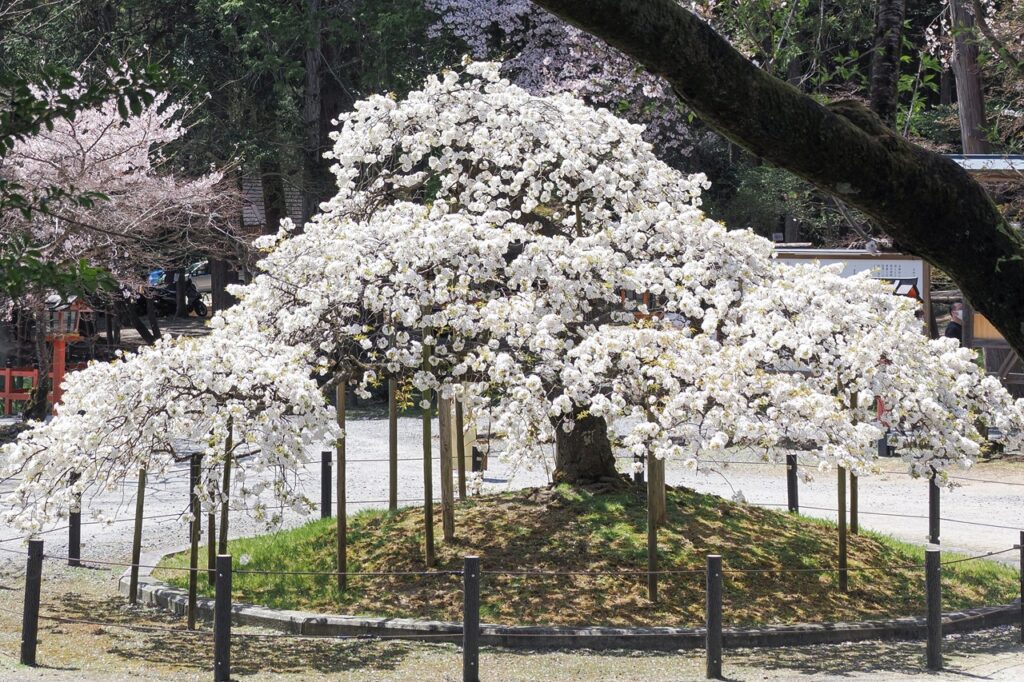

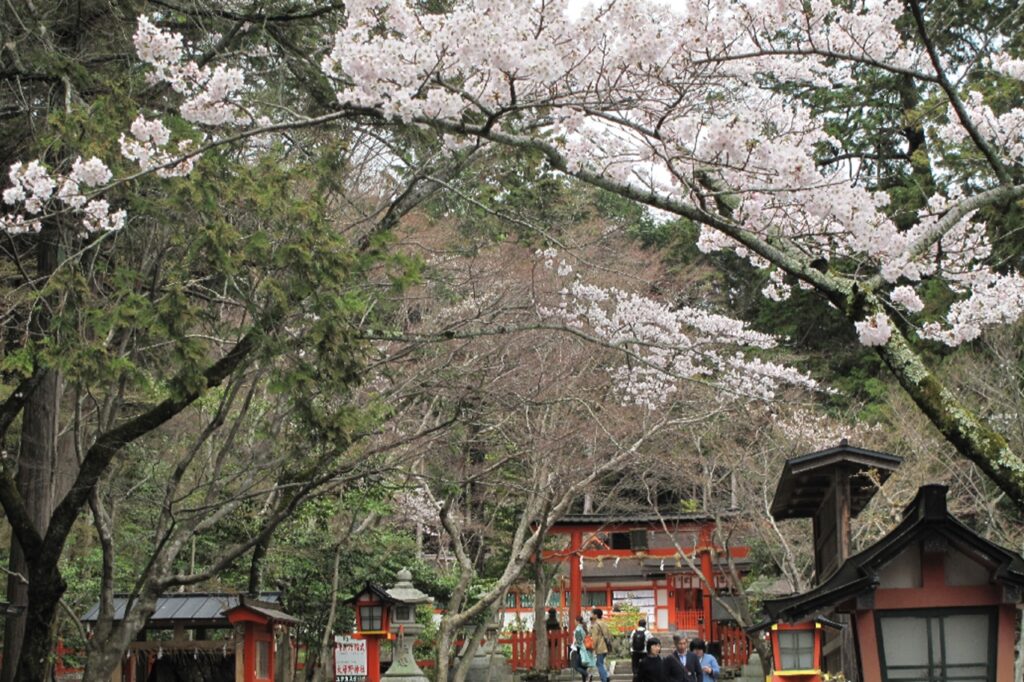

Best time to visit: Late March - early April
Hours of visitation/9:00-17:00 (reception at the shrine office)
Admission fee/free
Ishimizu Hachimangu Shrine, popularly known as "Yawata no Hachiman-san. The shrine is located in the Otokoyama area, which has been famous for its cherry blossoms since the Heian period (794-1185). In spring, visitors can enjoy the contrast between the cherry blossoms and fresh greenery along the approach cableway. The weeping cherry trees in the shrine garden and the cherry blossoms around the Edison monument are also highlights. The Otokoyama Cherry Blossom Festival is held from the first day of spring to April 30, and various festive events are held at the shrine.




Best time to visit: Late March - early April
Hours of visit (open/close time)/6:00-18:00
Admission fee/free
Over 600 interviews per year! An order site carefully selected by the editors who knows Kyoto and Shiga.
nowOfficial LINE friend registration500 yen OFF coupon is being issued!
Distributed every Friday morning at 8:00 am! From new restaurant information to event information that we want to share with you, We deliver articles about Kyoto that are useful to know. About 20,000 people have registered.Click here to add a friend!
 News
News Feature article
Feature article Featured event
Featured event